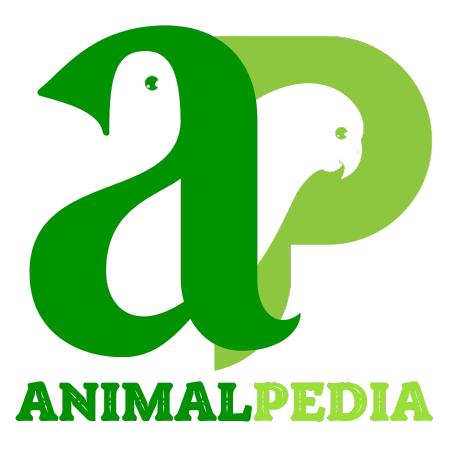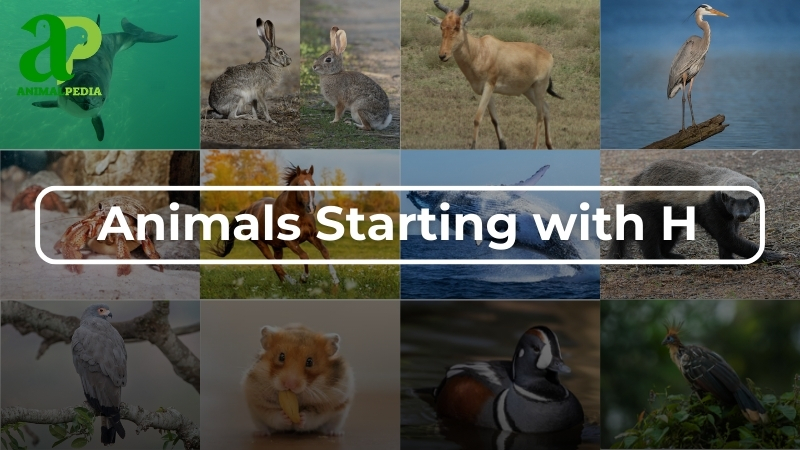Most Popular Animal Start with H
The animal kingdom is full of wonders, and exploring its incredible members never gets old. In this article, we’ll focus on some of the most fascinating creatures whose names begin with the letter H. From the graceful Heron to the powerful Hippopotamus, these animals showcase the diverse beauty and remarkable traits of life on Earth. Whether it’s the Humpback camel’s ability to raid beehives or the Husky’s unique flight style, these animals highlight the astonishing variety of species that share our planet.
| Horse | Husky | Honey Bee |
| Hare | Hyena | Honey Badger |
| Hummingbird | Hoatzin | Hippopotamus |
| Horseshoe Crab |
1. Horse
The horse, scientifically known as Equus ferus caballus, is a domesticated mammal in the Equidae family. Standing 4.5–6 feet at the shoulder and weighing 900–2,200 pounds, horses are highly adaptable and can thrive in diverse environments, from grasslands to human-modified habitats. Their coat colors range from black, brown, and gray to patterned combinations like pinto. Horses have muscular builds, strong legs, and hooves designed for endurance, with some breeds featuring unique traits like feathered legs.
Herbivorous by nature, horses graze on grass, hay, and grains throughout the day, requiring fresh water for hydration. Social animals, they live in herds led by a dominant mare and exhibit a hierarchy. Horses are active during the day, alternating between grazing, socializing, and resting. After an 11-month gestation, mares give birth to one foal, which they nurse and protect closely for the first few months.

| Attributes | Quick facts |
|---|---|
| Size | 4.5–6 ft (1.4–1.8 m) at the shoulder, depending on breed |
| Weight | 900–2,200 lbs (400–1,000 kg), varies by breed |
| Lifespan | 25–30 years |
| Habitat | Domesticated; adaptable to a variety of environments |
| Diet | Herbivorous; eats grass, hay, and grains |
| Social Structure | Lives in herds, typically led by a dominant mare |
| Conservation | Domesticated |
Fun Fact: Horses can sleep lying down or standing up thanks to a “stay apparatus” in their legs that locks their joints for stability!
2. Husky
The Husky, a domesticated breed of Canis lupus familiaris, is a medium-sized dog originally bred for cold climates and tasks like sledding. Standing 20–24 inches tall at the shoulder and weighing 35–60 pounds, they are well-suited for snowy and frigid environments but can adapt to moderate climates with proper care. Huskies have a compact, athletic build, a thick double coat for insulation, and distinct facial masks with blue, brown, or heterochromatic eyes. Their fluffy tails often curl over their backs, adding to their wolf-like appearance.
Energetic and social, Huskies thrive on human and canine companionship, requiring regular exercise and mental stimulation to stay healthy and happy. Their omnivorous diet includes protein, fat, and carbohydrates, which match their high energy levels. With a 63-day gestation period, Husky litters typically have 4–6 puppies, cared for by their mother and human handlers.
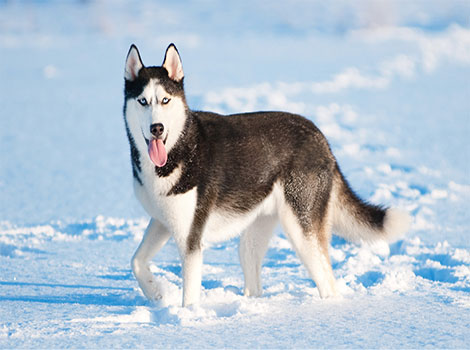
| Attributes | Quick facts |
|---|---|
| Size | 20–24 in (51–61 cm) at the shoulder |
| Weight | 35–60 lbs (16–27 kg) |
| Lifespan | 12–15 years |
| Habitat | Domesticated; originally bred for cold climates and sledding |
| Diet | Omnivorous; requires a balanced diet of protein, fat, and carbohydrates |
| Social Structure | Highly social; thrives in family environments or with other dogs |
| Conservation | Not evaluated |
Fun Fact: Huskies can regulate their metabolism exceptionally well, allowing them to run for hours without tiring—a trait that makes them exceptional sled dogs!
3. Honey Bee
The Honey Bee (Apis mellifera), a member of the Apidae family, is a vital pollinator found globally in natural and human-made hives. Measuring 0.4–0.6 inches long and weighing about 0.02 ounces, it thrives in temperate climates and environments abundant in flowers, such as meadows and gardens. Honey bees have yellow and black striped bodies with a fuzzy thorax, transparent wings, and a segmented shape. Females possess a stinger for defense, while their proboscis is used for nectar collection.
Honey bees feed on nectar, which they convert into honey for energy storage, and pollen, their primary protein source. Highly organized, they divide labor within the hive: workers forage, care for young, and build combs; drones mate with the queen, who lays fertilized eggs for workers and queens, and unfertilized eggs for drones.
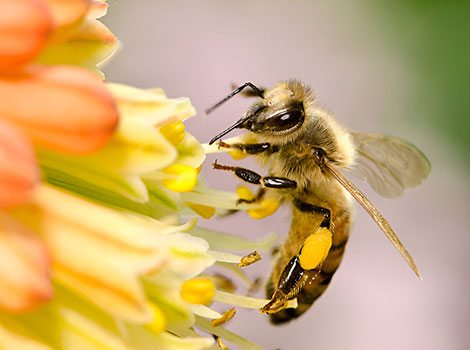
| Attributes | Quick facts |
|---|---|
| Size | 0.4–0.6 in (10–15 mm) |
| Weight | Approximately 0.02 oz (0.5 g) |
| Lifespan | Workers: 5–7 weeks; Queens: 1–5 years |
| Habitat | Found globally in hives; prefers areas with abundant flowers |
| Diet | Nectar and pollen; honey is produced for energy storage |
| Social Structure | Highly social; lives in colonies with a queen, workers, and drones |
| Conservation | Not evaluated |
Fun Fact: Honey bees perform a “waggle dance” to communicate food source locations, using precise movements to convey distance and direction!
4. Hare
Hares, members of the Leporidae family, are swift herbivores found in diverse habitats, including grasslands, woodlands, tundra, and deserts, across most of the globe except Antarctica. Measuring 16–28 inches in body length and weighing 6–15 pounds, they are built for speed, with powerful hind legs capable of running up to 45 mph and elongated ears for detecting predators and regulating temperature. Their coats vary by species and season, with many turning white in winter for camouflage in snowy environments.
Primarily solitary, hares are most active at dawn and dusk, feeding on grass, leaves, bark, and twigs. They rest in shallow depressions called “forms” during the day. Breeding prolifically, females give birth to 2–6 leverets after a 42-day gestation. Leverets are born fully furred and with open eyes, making them semi-independent shortly after birth.
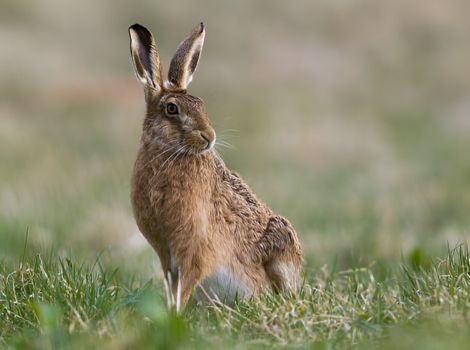
| Attributes | Quick facts |
|---|---|
| Size | 16–28 in (40–70 cm) body; tail 2–4 in (5–10 cm) |
| Weight | 6–15 lbs (2.7–7 kg), depending on species |
| Lifespan | 4–8 years in the wild; up to 12 years in captivity |
| Habitat | Grasslands, woodlands, tundra, and deserts worldwide, except Antarctica |
| Diet | Herbivorous; feeds on grass, leaves, bark, and twigs |
| Social Structure | Solitary or loosely social, except during mating season |
| Conservation | Least Concern |
Fun Fact: Hares use their incredible speed and zig-zagging movement to outmaneuver predators, making them some of nature’s most agile runners!
5. Hyena
Hyenas, members of the Hyaenidae family, are robust carnivores found in Africa and parts of Asia, thriving in diverse habitats like savannas, grasslands, and arid deserts. Measuring 3–5 feet in length and weighing 90–190 pounds, they are known for their sloping backs, strong necks, and powerful jaws capable of crushing bones. Coat patterns vary by species: spotted hyenas have distinctive spots, striped hyenas have bold stripes, and brown hyenas have dark, shaggy fur.
Opportunistic feeders, hyenas scavenge carrion but are also skilled hunters, preying on animals like wildebeest and antelope, often using teamwork in their matriarchal clans of up to 80 individuals. Nocturnal by nature, they are also active during the day in protected areas. After a 110-day gestation, females give birth to 2–4 cubs, nursing them for up to 16 months and teaching vital survival skills.
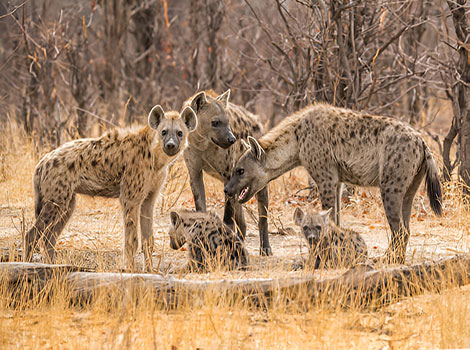
| Attributes | Quick facts |
|---|---|
| Size | 3–5 ft (90–150 cm) body; shoulder height 2.5–3 ft (75–90 cm) |
| Weight | 90–190 lbs (40–86 kg), varies by species |
| Lifespan | 12–20 years in the wild; up to 25 years in captivity |
| Habitat | Savannas, grasslands, woodlands, and deserts in Africa and parts of Asia |
| Diet | Carnivorous; primarily scavengers but also skilled hunters |
| Social Structure | Lives in clans of up to 80 individuals, led by dominant females |
| Conservation | Least Concern |
Fun Fact: Hyenas’ iconic “laughter” is not for joy but a form of communication, conveying social status, excitement, or stress within the clan!
6. Honey Badger
The Honey Badger (Mellivora capensis), a member of the Mustelidae family, is a fearless and resourceful mammal found across Africa, Southwest Asia, and India. Measuring 22–30 inches in length and weighing 13–30 pounds, it has a stocky, muscular build with strong claws and a black body accentuated by a white or grayish cape running from head to tail. Its thick, loose skin provides protection against predators, allowing it to twist and fight back when attacked.
Honey Badgers are omnivorous, feasting on small mammals, reptiles, insects, fruits, and honey, often raiding beehives for their favorite treat. Solitary and primarily nocturnal, they are highly aggressive when threatened and capable of fending off larger predators. After a 6–8 week gestation, females give birth to 1–2 cubs, which stay with their mother for up to 18 months to learn essential survival skills.
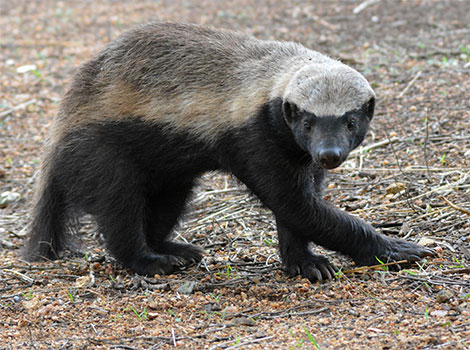
| Attributes | Quick facts |
|---|---|
| Size | 22–30 in (56–77 cm) body; tail 6–12 in (15–30 cm) |
| Weight | 13–30 lbs (6–14 kg) |
| Lifespan | 7–10 years in the wild; up to 24 years in captivity |
| Habitat | Grasslands, savannas, and forests in Africa, Southwest Asia, and India |
| Diet | Omnivorous; eats small mammals, birds, reptiles, insects, fruits, and honey |
| Social Structure | Solitary, except during mating or with young |
| Conservation | Least Concern |
Fun Fact: Renowned for their ingenuity, Honey Badgers have been observed escaping enclosures and even fending off lions with their fearless nature!
7. Hummingbird
Hummingbirds, members of the Trochilidae family, are tiny, agile birds native to the Americas, ranging from Alaska to Tierra del Fuego. Measuring 3–5 inches long and weighing just 0.1–0.3 ounces, they exhibit vibrant, iridescent plumage in shades of green, blue, red, and orange. With compact bodies, long slender bills, and wings capable of beating up to 80 times per second, they are uniquely adapted for hovering and flying in all directions, including backward.
Omnivorous, they consume nectar for energy and supplement their diet with insects and spiders for protein. Hummingbirds are highly territorial and spend much of their day feeding, consuming half their body weight in food daily to sustain their rapid metabolism. Females build tiny nests and care for 1–3 chicks, feeding them regurgitated nectar and insects until they fledge.
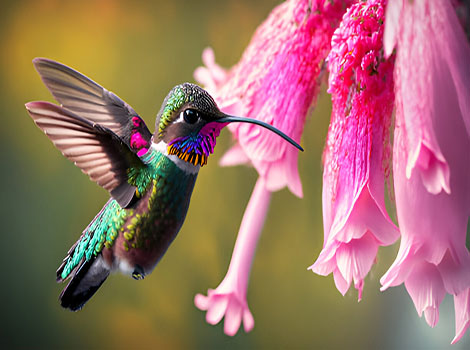
| Attributes | Quick facts |
|---|---|
| Size | 3–5 in (7.5–13 cm), depending on species |
| Weight | 0.1–0.3 oz (2–8 g) |
| Lifespan | 3–5 years in the wild; up to 10 years in captivity |
| Habitat | Forests, grasslands, and gardens in the Americas |
| Diet | Nectar, small insects, and spiders |
| Social Structure | Solitary, except during breeding or migration |
| Conservation | Least Concern |
Fun Fact: Hummingbirds are the only birds capable of flying backward, thanks to their ball-and-socket shoulder joints!
8. Hoatzin
The Hoatzin (Opisthocomus hoazin), also known as the “stinkbird,” is a unique bird found in the swamps, mangroves, and riverine forests of South America, particularly along the Amazon and Orinoco basins. Measuring 25–27 inches long and weighing 1.8–2.4 pounds, it is easily identified by its spiky crest, blue face, red eyes, and streaked brown plumage. Juvenile hoatzins possess clawed fingers on their wings, which help them climb but disappear as they mature.
This herbivorous bird feeds primarily on leaves, flowers, and fruits, using a fermentation process in its crop similar to that of cows, which gives it a strong odor. Social and diurnal, Hoatzins live in small flocks, perching near water to feed and roost. During the rainy season, they breed in tree nests overhanging water, with both parents incubating 2–3 eggs and caring for the chicks, which can climb back to the nest if they fall.
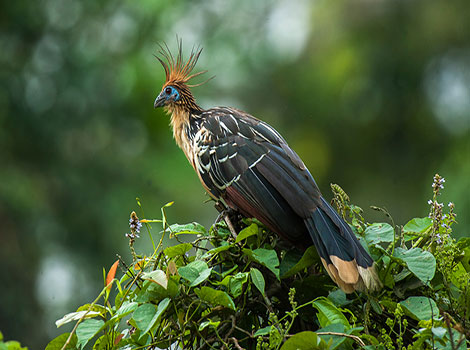
| Attributes | Quick facts |
|---|---|
| Size | 25–27 in (65–70 cm) |
| Weight | 1.8–2.4 lbs (800–1,100 g) |
| Lifespan | 10–15 years |
| Habitat | Swamps, mangroves, and riverine forests in South America |
| Diet | Herbivorous; primarily eats leaves, flowers, and fruits |
| Social Structure | Lives in small flocks or family groups |
| Conservation | Least Concern |
Fun Fact: The Hoatzin’s fermentation-based digestion gives it an odor that has earned it the nickname “stinkbird”!
9. Hippopotamus
The Hippopotamus (Hippopotamus amphibius) is a massive semi-aquatic mammal found in sub-Saharan Africa’s rivers, lakes, and wetlands. Measuring 10–16 feet long, standing 4–5 feet tall at the shoulder, and weighing up to 4,400 pounds, it has a barrel-shaped body, short legs, and a broad mouth. Its grayish-purple skin with pinkish hues around the eyes and ears is sensitive to the sun, so hippos spend most of the day submerged in water to stay cool and hydrated.
Herbivorous by nature, hippos graze on grass at night, consuming up to 80 pounds and traveling up to 6 miles from water to feed. They are social animals, living in pods of 10–30 led by a dominant male. Females give birth underwater every two years, nursing their calves for up to eight months and fiercely protecting them.
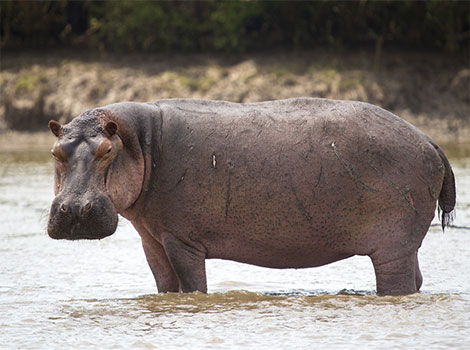
| Attributes | Quick facts |
|---|---|
| Size | 10–16 ft (3–5 m) length; 4–5 ft (1.2–1.5 m) shoulder height |
| Weight | 2,200–4,400 lbs (1,000–2,000 kg) |
| Lifespan | 40–50 years |
| Habitat | Rivers, lakes, and wetlands in sub-Saharan Africa |
| Diet | Herbivorous; primarily grazes on grass at night |
| Social Structure | Lives in pods of 10–30 individuals, dominated by a male |
| Conservation | Vulnerable |
Fun Fact: Despite their size, hippos can run up to 19 mph on land, making them both surprisingly fast and one of Africa’s most dangerous animals!
10. Horseshoe Crab
The Horseshoe Crab, part of the Limulidae family, is a fascinating marine arthropod more closely related to spiders and scorpions than true crabs. Measuring 18–24 inches in length, including its tail (telson), and weighing up to 10 pounds, it inhabits shallow coastal waters and estuaries in North America and Asia, favoring sandy or muddy bottoms. Its hard, dome-shaped shell is brown or greenish, and it features a long telson for self-righting, along with advanced compound and simple eyes.
These nocturnal creatures feed on worms, mollusks, and small crustaceans, using their legs to crush and grind food. During breeding, males attach to females, fertilizing eggs laid in sandy nests near shorelines. The eggs develop without parental care, and larvae return to the sea after hatching.
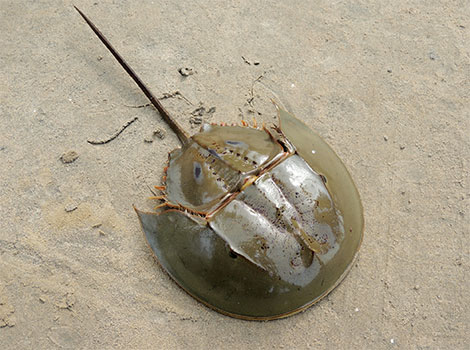
| Attributes | Quick facts |
|---|---|
| Size | 18–24 inches (46–61 cm, including tail) |
| Weight | 3.5–10 lb (1.5–4.5 kg) |
| Lifespan | 20–40 years |
| Habitat | Shallow coastal waters and estuaries in North America and Asia |
| Diet | Worms, mollusks, and small crustaceans |
| Social Structure | Solitary, except during breeding season |
| Conservation | Vulnerable |
Fun Fact: Horseshoe crab blood is bright blue due to its copper content and is vital in the pharmaceutical industry for detecting bacterial contamination!
Having explored some popular animals, it’s time to focus on mammals that start with ‘H.’ These warm-blooded species exhibit remarkable diversity and survival skills in varied ecosystems.
Mammals that start with H
Mammals starting with ‘H’ include fascinating species like the hippopotamus and hedgehog. These creatures demonstrate incredible adaptability, making them integral to their respective environments.
| Harlequin Rabbit | Highland Cattle | Hovawart |
| Hamster | Hartebeest | Harbor Seal |
| Howler Monkey | Hyrax | Hoary Bat |
| Humpback Whale | Harbor Porpoise | Harp Seal |
| Honduran White Bat | Hazel Dormouse | Hooded Seal |
| Hawaiian Monk Seal |
11. Harlequin Rabbit
The Harlequin Rabbit (Oryctolagus cuniculus domesticus) is a medium-sized domesticated breed, weighing 6.5–9.5 pounds. Known for its striking coat patterns of alternating colors, such as orange and black or white and blue, the symmetry of its markings adds to its popularity as a show rabbit and pet. These social rabbits have rounded bodies, long ears, and soft fur, thriving in clean, spacious environments with protection from extreme weather and predators.
Herbivorous grazers, Harlequins need unlimited access to hay for digestive health, supplemented with fresh vegetables and rabbit pellets. Active at dawn and dusk, they enjoy exploring, playing, and bonding with humans or other rabbits. Female Harlequins have a 28–31 day gestation, giving birth to 4–12 kits, which they nurse for 3–4 weeks.
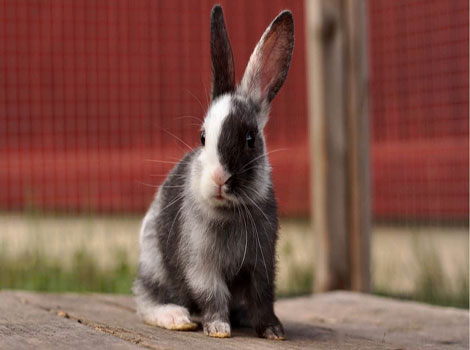
| Attributes | Quick facts |
|---|---|
| Size | 6.5–9.5 lbs (3–4.3 kg) |
| Lifespan | 5–8 years; up to 10 years with proper care |
| Habitat | Domesticated; requires clean, spacious enclosures |
| Diet | Herbivorous; hay, fresh vegetables, and rabbit pellets |
| Social Structure | Social; enjoys companionship from humans or other rabbits |
| Conservation | Domesticated |
Fun Fact: Harlequin rabbits are nicknamed the “clown of rabbits” for their playful personalities and vibrant, mismatched coat patterns!
12. Highland Cattle
Highland Cattle (Bos taurus) are a hardy breed from Scotland, well-known for their adaptability to cold, rugged climates. Standing 3.5–4.5 feet at the shoulder and weighing 900–1,800 pounds, these stocky animals are distinguished by their thick, double-layered coats. The outer layer repels water, while the inner layer provides insulation, allowing them to endure harsh winters. Their coats come in a variety of colors, including red, black, yellow, and brindle, with red being most common. Long, curved horns add to their iconic appearance.
Herbivorous and efficient grazers, Highland cattle thrive on grass, hay, and even low-quality forage in sparse terrains. Social and docile, they live in herds, with cows giving birth to a single calf after a 9-month gestation. Calves are strong at birth, quickly able to follow their attentive mothers.
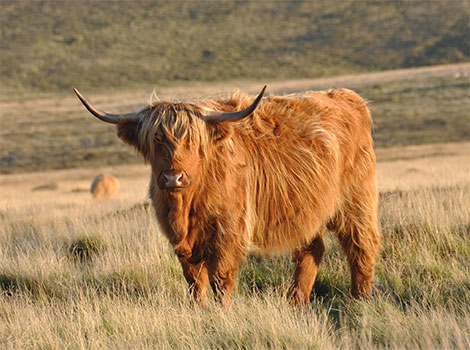
| Attributes | Quick facts |
|---|---|
| Size | 3.5–4.5 ft (110–135 cm) at the shoulder |
| Weight | 900–1,800 lbs (400–800 kg), depending on sex |
| Lifespan | 15–20 years |
| Habitat | Pastures and mountainous regions, particularly in Scotland |
| Diet | Herbivorous; primarily grass and hay |
| Social Structure | Social; lives in herds |
| Conservation | Not evaluated |
Fun Fact: Highland cattle are one of the oldest registered breeds, tracing their lineage back to the 6th century, and are popular for conservation grazing and eco-tourism due to their gentle temperament and striking looks!
13. Hovawart
The Hovawart, a medium to large dog breed, is a versatile and intelligent member of the Canidae family. Measuring 23–29 inches tall and weighing 55–90 pounds, it features a strong, athletic body with a long, flowing double coat in black, black-and-tan, or blonde. Originating in Germany, the Hovawart thrives in temperate climates and adapts well to various environments, including homes with yards or rural settings.
Known for their loyalty, intelligence, and protective nature, Hovawarts excel as watchdogs and family companions. They require regular exercise and mental stimulation to remain happy and healthy. After a 63-day gestation, litters usually consist of 6–8 puppies. Early socialization and training are essential, supported by their attentive mothers and human caregivers.
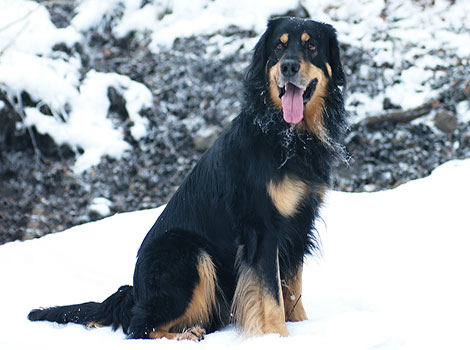
| Attributes | Quick facts |
|---|---|
| Size | 23–29 in (58–73 cm) |
| Weight | 55–90 lbs (25–41 kg) |
| Lifespan | 10–14 years |
| Habitat | Domesticated; adaptable to various environments |
| Diet | Omnivorous; balanced dog food or natural diet |
| Social Structure | Highly social; thrives in families or with other dogs |
| Conservation | Not evaluated |
Fun Fact: The name “Hovawart” comes from Middle High German, meaning “estate guard,” reflecting their historical role as reliable watchdogs on farms and estates!
14. Hamster
Hamsters, members of the subfamily Cricetinae, are small, nocturnal rodents native to parts of Europe and Asia. Measuring 2–7 inches long and weighing 0.9–10 ounces, they are known for their rounded bodies, short tails, and expandable cheek pouches used for transporting food. Their coats come in various colors, including golden, brown, gray, and white, depending on the species, such as the Syrian hamster (Mesocricetus auratus) or dwarf hamsters.
Omnivorous by nature, hamsters feed on seeds, grains, fruits, vegetables, and occasionally small insects, often hoarding food in their nests for later use. Solitary in behavior (except for some dwarf species), they are most active at night, spending their time digging, foraging, and exploring. Females give birth to 6–12 pups after a 16–22 day gestation, with pups becoming independent after 3–4 weeks.
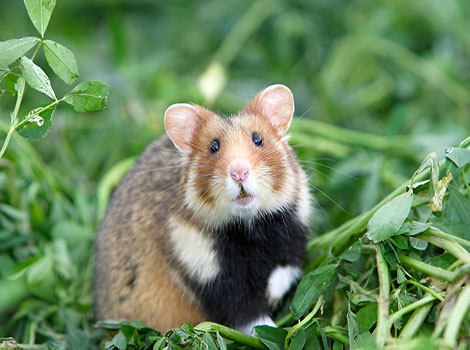
| Attributes | Quick facts |
|---|---|
| Size | 2–7 in (5–18 cm), depending on species |
| Weight | 0.9–10 oz (25–280 g), varies by breed |
| Lifespan | 1.5–3 years |
| Habitat | Domesticated; wild hamsters inhabit deserts and grasslands in Europe and Asia |
| Diet | Omnivorous; eats seeds, grains, fruits, vegetables, and occasional insects |
| Social Structure | Solitary (except dwarf hamsters, which may live in pairs or groups) |
| Conservation | Least Concern |
Fun Fact: Hamsters have poor eyesight and rely on their sharp sense of smell and sensitive whiskers to navigate their surroundings!
15. Hartebeest
The Hartebeest (Alcelaphus spp.) is a large antelope native to sub-Saharan Africa, thriving in grasslands, savannas, and open woodlands. Measuring 5–7 feet in length, standing 3.5–4.5 feet tall at the shoulder, and weighing 260–440 pounds, it is built for speed with a slender, elongated body and long legs. Coat colors range from tan to reddish-brown, often with darker markings on the face and legs, and both males and females sport distinctive lyre-shaped or “S”-shaped horns.
Hartebeests are herbivorous, grazing primarily on grasses and capable of surviving on low-quality forage during dry seasons. Highly social, they live in herds of 20–300 individuals, with dominant males defending territories and females forming groups with juveniles. After an 8-month gestation, females give birth to a single calf, typically timed with the rainy season. Calves stand within hours of birth and stay close to their mothers for several months.
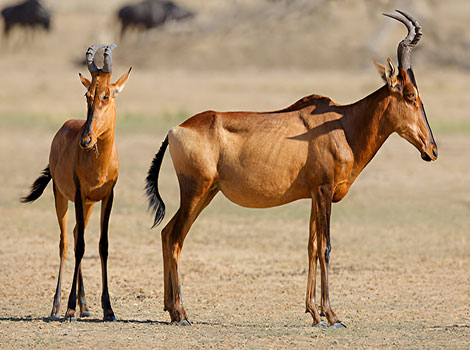
| Attributes | Quick facts |
|---|---|
| Size | 5–7 ft (150–215 cm) body; shoulder height 3.5–4.5 ft (110–140 cm) |
| Weight | 260–440 lbs (120–200 kg) |
| Lifespan | 12–20 years |
| Habitat | Grasslands, savannas, and open woodlands in sub-Saharan Africa |
| Diet | Herbivorous; feeds primarily on grasses |
| Social Structure | Lives in herds of 20–300 individuals, depending on species and season |
| Conservation | Least Concern |
Fun Fact: Hartebeests are exceptional runners, reaching speeds of up to 43 mph and maintaining them over long distances to outpace predators!
16. Harbor Seal
The Harbor Seal (Phoca vitulina), a member of the Phocidae family, is a versatile marine mammal found along the coastal waters, estuaries, and rocky shorelines of the Northern Hemisphere. Measuring 4.5–6.2 feet long and weighing 120–370 pounds, they exhibit a streamlined body, short flippers, and a rounded head. Their coats vary from gray to brown, often adorned with darker spots and patches, and a lighter belly. A thick layer of blubber insulates them in cold waters, while their whiskers aid in detecting prey.
Carnivorous by nature, Harbor Seals primarily feed on fish, supplemented by squid and crustaceans. Skilled divers, they can plunge to depths of 500 meters and hold their breath for up to 20 minutes. Typically solitary, they form groups, or “haul-outs,” on shorelines for resting or breeding. Females give birth to a single pup after an 11-month gestation. Pups can swim hours after birth and rely on their mothers for 4–6 weeks.
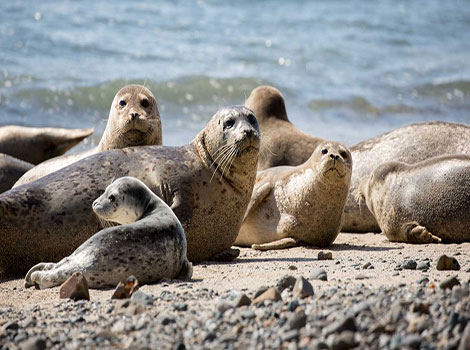
| Attributes | Quick facts |
|---|---|
| Size | 4.5–6.2 ft (1.4–1.9 m) |
| Weight | 120–370 lbs (55–170 kg) |
| Lifespan | 20–30 years |
| Habitat | Coastal waters, estuaries, and rocky shorelines in the Northern Hemisphere |
| Diet | Carnivorous; feeds on fish, squid, and crustaceans |
| Social Structure | Solitary but gathers in groups during resting and breeding |
| Conservation | Least Concern |
Fun Fact: Harbor seals can sleep underwater, automatically surfacing to breathe while remaining at rest!
17. Howler Monkey
Howler Monkeys (Alouatta spp.), members of the Atelidae family, are medium-sized primates native to Central and South America, from southern Mexico to northern Argentina. Measuring 16–28 inches in body length, with tails extending 20–30 inches, they weigh 8–22 pounds. Their prehensile tails aid in navigating their arboreal habitat in tropical forests, where they thrive in warm, humid climates. Coat colors vary by species, ranging from black to reddish-brown.
Primarily herbivorous, Howler Monkeys consume leaves, fruits, and flowers, spending much of their time foraging. Known for their deafening territorial howls, audible up to 3 miles, they use their specialized hyoid bones to produce these distinctive calls. Social by nature, they live in troops of 6–15 members. Females give birth to a single infant after a 6-month gestation, nursing and carrying the young for several months.
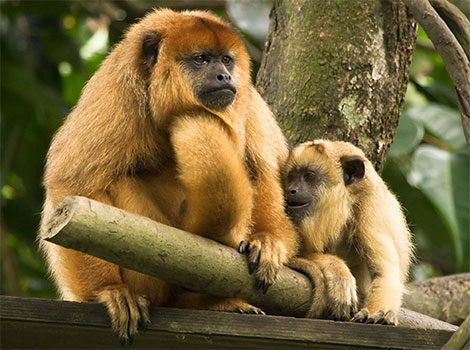
| Attributes | Quick facts |
|---|---|
| Size | 16–28 in (40–70 cm) body; tail 20–30 in (50–75 cm) |
| Weight | 8–22 lbs (3.5–10 kg) |
| Lifespan | 15–20 years in the wild |
| Habitat | Tropical forests in Central and South America |
| Diet | Herbivorous; primarily eats leaves, fruits, and flowers |
| Social Structure | Lives in troops of 6–15 individuals |
| Conservation | Least Concern |
Fun Fact: Howler monkeys are the loudest land animals, and their vocalizations can identify individual species!
18. Hyrax
Hyraxes (Procavia spp.), small herbivorous mammals from the Procaviidae family, inhabit rocky areas, forests, and savannas across Africa and the Middle East. Measuring 12–21 inches in length and weighing 4–11 pounds, they have compact bodies, short legs, and fur ranging from gray to brown, blending with their rocky surroundings. Their specialized feet, with rubbery pads and sweat glands, provide excellent grip on uneven surfaces.
Primarily grazers and browsers, hyraxes feed on grass, leaves, bark, and fruit, usually in the early morning or late afternoon. Diurnal and social, they live in colonies of 10–80 individuals, basking in the sun to regulate their temperature and relying on lookout members to warn of predators. After a 7–8 month gestation, females give birth to 2–4 young, which are furred and active at birth and integrate into the colony quickly.
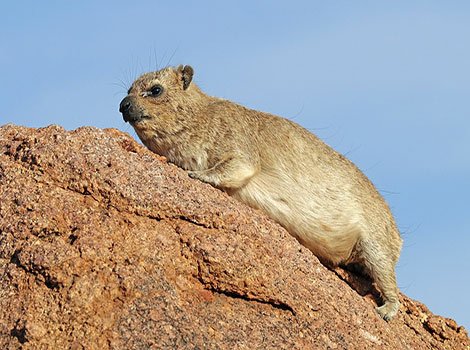
| Attributes | Quick facts |
|---|---|
| Size | 12–21 in (30–53 cm) |
| Weight | 4–11 lbs (2–5 kg) |
| Lifespan | 8–12 years in the wild; up to 14 years in captivity |
| Habitat | Rocky areas, forests, and savannas in Africa and the Middle East |
| Diet | Herbivorous; eats grass, leaves, bark, and fruit |
| Social Structure | Lives in colonies of 10–80 individuals |
| Conservation | Least Concern |
Fun Fact: Despite their small size, hyraxes are closely related to elephants and manatees, sharing evolutionary traits like similar teeth and skull structures!
19. Hoary Bat
The Hoary Bat (Lasiurus cinereus), a member of the Vespertilionidae family, is a medium-sized bat found across North and South America, from Canada to Argentina. Measuring 5–6 inches in length with a wingspan of 13–16 inches, it weighs just 0.9–1.4 ounces. Its dense, dark brown fur has a frosted or “hoary” appearance due to white tips, with wings displaying a silvery sheen, providing insulation for cool nights.
Primarily insectivorous, Hoary Bats feed on moths, beetles, and flies, using echolocation to hunt at night. They are solitary and nocturnal, roosting in trees during the day and migrating long distances between breeding and wintering grounds. Mating occurs in autumn, with females giving birth to 1–4 pups in late spring. Mothers nurse their pups until they can forage independently, usually within 3–4 weeks.
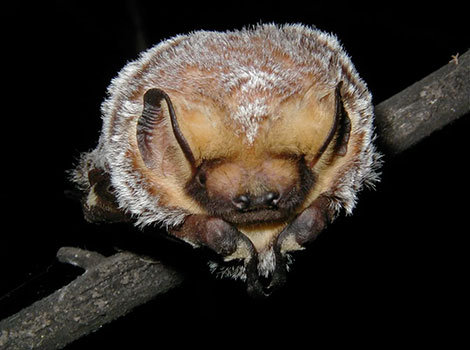
| Attributes | Quick facts |
|---|---|
| Size | 5–6 in (12–15 cm) body; wingspan 13–16 in (33–41 cm) |
| Weight | 0.9–1.4 oz (25–40 g) |
| Lifespan | 6–14 years |
| Habitat | Forests and woodlands across North and South America |
| Diet | Insectivorous; feeds on moths, beetles, and other nocturnal insects |
| Social Structure | Solitary |
| Conservation | Least Concern |
Fun Fact: Hoary bats are remarkable migrators, capable of traveling over 1,000 miles during seasonal migrations!
20. Humpback Whale
The Humpback Whale (Megaptera novaeangliae), a member of the Balaenopteridae family, is a majestic marine mammal found in oceans worldwide. Measuring 40–60 feet long and weighing 25–40 tons, they are known for their streamlined bodies, large flippers (up to a third of their body length), and unique white patterns on the underside of their flukes. These markings help identify individual whales. Their knobby heads are covered in tubercles, small sensory nodules.
Carnivorous, Humpbacks feed on krill, plankton, and small schooling fish, often using bubble-net feeding, a cooperative hunting strategy. They are solitary but may form temporary pods during feeding or migration. Known for acrobatic breaches and tail-slapping, they also produce complex songs during the breeding season. After a 12-month gestation, females give birth to a single calf every 2–3 years, nursing them on rich milk and guiding them through early development.
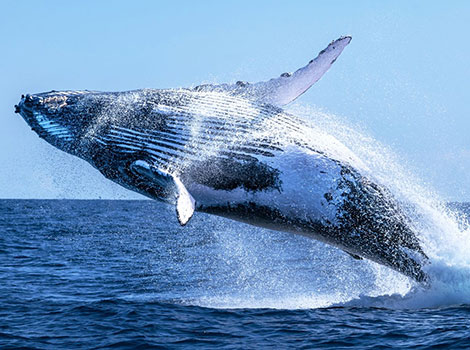
| Attributes | Quick facts |
|---|---|
| Size | 40–60 ft (12–18 m) |
| Weight | 25–40 tons (22,000–36,000 kg) |
| Lifespan | 45–50 years |
| Habitat | Oceans worldwide, primarily near coastlines during migration |
| Diet | Carnivorous; feeds on krill, plankton, and small fish using bubble-net feeding |
| Social Structure | Solitary or small groups, called pods |
| Conservation | Least Concern |
Fun Fact: Male humpback whales sing intricate songs that can last up to 20 minutes and are repeated for hours, traveling vast distances underwater!
21. Harbor Porpoise
The Harbor Porpoise (Phocoena phocoena), a small member of the Phocoenidae family, is found in the cooler coastal waters of the North Atlantic, North Pacific, and Arctic Oceans. Measuring 4.9–6.6 feet long and weighing 120–200 pounds, it has a compact body, a rounded head, and a small triangular dorsal fin. Its dark gray to brown back, lighter sides, and white underside provide effective camouflage in the water.
Carnivorous, Harbor Porpoises feed on small schooling fish, squid, and crustaceans, using echolocation to locate prey and diving up to 650 feet during hunts. Typically shy and elusive, they are found in small groups of 2–5 but may form larger aggregations during feeding. Females give birth to a single calf after an 11-month gestation, nursing them for up to a year while providing protection and guidance.
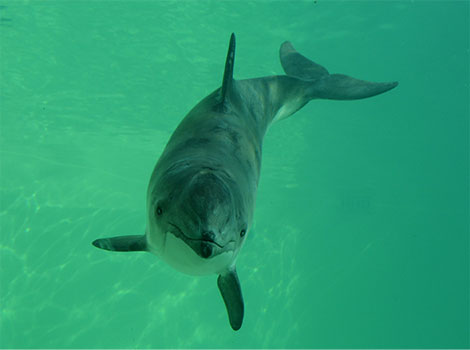
| Attributes | Quick facts |
|---|---|
| Size | 4.9–6.6 ft (1.5–2 m) |
| Weight | 120–200 lbs (54–91 kg) |
| Lifespan | 8–12 years in the wild |
| Habitat | Coastal and temperate waters of the North Atlantic, North Pacific, and Arctic Oceans |
| Diet | Carnivorous; feeds on fish, squid, and crustaceans |
| Social Structure | Found in small groups of 2–5 individuals |
| Conservation | Least Concern |
Fun Fact: Harbor porpoises are one of the smallest cetaceans and are known for their quiet, stealthy nature, making them challenging to spot in the wild!
22. Harp Seal
The Harp Seal (Pagophilus groenlandicus), a member of the Phocidae family, thrives in the icy waters of the Arctic and North Atlantic Oceans near Greenland, Canada, Norway, and Russia. Measuring 5–6 feet long and weighing 260–300 pounds, adults are gray with a distinctive black, harp-shaped marking on their back. Pups, known as “whitecoats,” are born with fluffy white fur that provides insulation.
Harp Seals are carnivorous, feeding primarily on fish like capelin and Arctic cod, as well as crustaceans. They dive up to 985 feet, using their keen underwater vision and whiskers to detect prey. Highly social and migratory, they travel thousands of miles between breeding and feeding grounds. After an 11.5-month gestation, females give birth to a single pup. The pup nurses for about 12 days, gaining weight rapidly on high-fat milk before being weaned and left to survive independently.
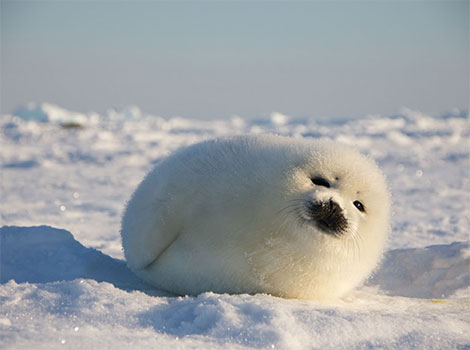
| Attributes | Quick facts |
|---|---|
| Size | 5–6 ft (1.5–1.8 m) |
| Weight | 260–300 lbs (120–140 kg) |
| Lifespan | 20–30 years |
| Habitat | Arctic and North Atlantic Oceans; prefers pack ice and open water |
| Diet | Carnivorous; feeds on fish, crustaceans, and small invertebrates |
| Social Structure | Social, often found in large groups on ice and in the water |
| Conservation | Least Concern |
Fun Fact: Harp Seals can hold their breath for up to 15 minutes, a crucial adaptation for hunting under ice and avoiding predators!
The Harp Seal (Pagophilus groenlandicus) is a species of earless seal native to the North Atlantic and Arctic Oceans. Known for their distinctive black harp-shaped markings on their backs, these seals spend much of their lives in icy waters, where they primarily feed on fish and invertebrates. Harp seals are characterized by their thick layer of blubber, which provides insulation against the cold and buoyancy in the water. They are social animals, often found in large colonies during the breeding season, where females give birth to pups on pack ice.
Fun Fact:
Harp seals are famous for their annual migration, which involves long-distance journeys between their breeding and feeding grounds.
23. Honduran White Bat
The Honduran White Bat (Ectophylla alba), a tiny member of the Phyllostomidae family, inhabits the tropical rainforests of Central America, including Honduras, Nicaragua, Costa Rica, and Panama. Measuring just 1.5–2 inches long and weighing 0.2–0.35 ounces, these bats are distinguished by their white fur, paired with a yellow-orange nose and ears. They are known for constructing “tents” by chewing and folding large leaves, creating shelters that protect them from predators and rain.
Frugivorous, Honduran White Bats primarily feed on figs, staying close to their roosts while foraging. Nocturnal and social, they live in small groups of up to 15 individuals, typically consisting of one male and multiple females. After a 3–4 month gestation, females give birth to a single pup, which they nurse and care for until it is weaned and independent.
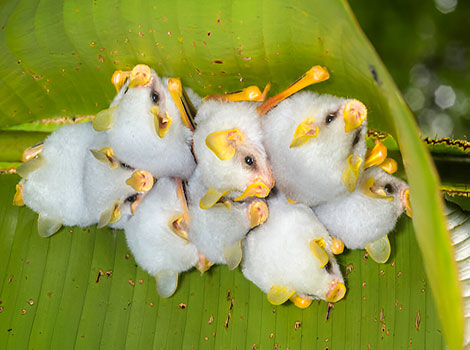
| Attributes | Quick facts |
|---|---|
| Size | 1.5–2 in (3.8–5 cm) |
| Weight | 0.2–0.35 oz (5–10 g) |
| Lifespan | 5–10 years |
| Habitat | Tropical rainforests in Central America, particularly in lowland areas |
| Diet | Frugivorous; primarily feeds on figs and other fruits |
| Social Structure | Lives in small groups of up to 15 individuals |
| Conservation | Near Threatened |
Fun Fact: The white fur of these bats appears greenish under sunlight filtering through their leafy roosts, providing excellent camouflage in their rainforest habitats!
24. Hazel Dormouse
The hazel dormouse (Muscardinus avellanarius) is a tiny rodent with a body length of 2.4–3.5 inches (6–9 cm) and a bushy tail of 2.4–2.8 inches (6–7 cm). Weighing only 0.5–1 ounce (15–30 grams), it lives in woodlands, hedgerows, and dense shrubs across Europe and western Asia, preferring mild climates. This nocturnal forager feeds on nuts, berries, flowers, and insects, using its agility to navigate trees and bushes. Dormice hibernate for about six months in colder weather, nesting under logs or dense vegetation.
These mostly solitary animals may form small groups during the breeding season. Females give birth to 4–5 young, which are blind and helpless at birth but become independent by summer’s end. Unfortunately, deforestation and habitat loss have led to their vulnerable status.
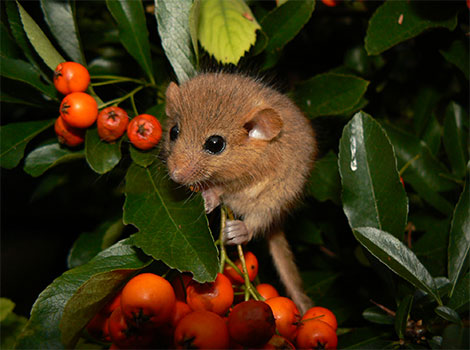
| Attributes | Quick facts |
|---|---|
| Size | 2.4–3.5 in (6–9 cm) body; tail 2.4–2.8 in (6–7 cm) |
| Weight | 0.5–1 oz (15–30 g) |
| Lifespan | 3–5 years in the wild; up to 7 years in captivity |
| Habitat | Woodlands, hedgerows, and dense shrubbery in Europe and western Asia |
| Diet | Omnivorous; eats nuts, fruits, flowers, and insects |
| Social Structure | Solitary; interacts mainly during breeding season |
| Conservation | Vulnerable |
Fun fact: Hazel dormice, the only native dormouse species in the UK, are vital indicators of woodland health, reflecting the biodiversity of their habitats.
25. Hooded Seal
The Hooded Seal (Cystophora cristata), a member of the Phocidae family, inhabits the icy waters of the Arctic and North Atlantic Oceans near Greenland, Canada, Norway, and Russia. Measuring 7–10 feet long and weighing 400–900 pounds, adults are silvery-gray with dark spots. Males are known for their inflatable nasal sac, or “hood,” which they inflate to attract females or deter rivals, along with a striking red nasal membrane used during displays.
Carnivorous, Hooded Seals dive to depths of up to 1,000 meters (3,280 feet) and can remain underwater for 25 minutes to hunt fish, squid, and crustaceans. Typically solitary, they gather on pack ice during breeding. After an 11-month gestation, females give birth to a single pup, nursing it for just 4–5 days—the shortest lactation of any mammal. During this time, pups, called “bluebacks” for their bluish-gray fur, gain weight rapidly before being left to survive independently.
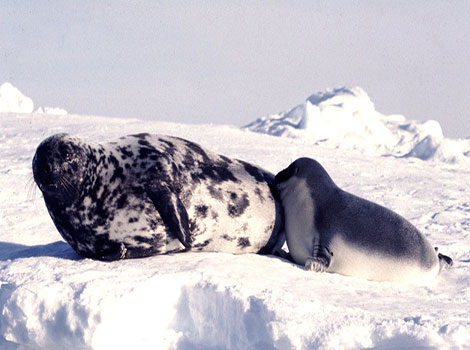
| Attributes | Quick facts |
|---|---|
| Size | 7–10 ft (2.1–3 m) |
| Weight | 400–900 lbs (180–410 kg) |
| Lifespan | 25–30 years |
| Habitat | Arctic and North Atlantic Oceans; prefers pack ice and open waters |
| Diet | Carnivorous; feeds on fish, squid, and crustaceans |
| Social Structure | Solitary except during breeding season |
| Conservation | Vulnerable |
Fun Fact: Hooded seal pups’ dense “blueback” fur provides excellent insulation, helping them endure the Arctic’s frigid conditions!
26. Hawaiian Monk Seal
The Hawaiian Monk Seal (Neomonachus schauinslandi), part of the Phocidae family, is a rare marine mammal endemic to the Hawaiian Islands. Measuring 7–7.5 feet long and weighing 400–600 pounds, adults have gray to brown coats with lighter bellies, while pups are born with sleek black fur. Adapted for aquatic life, they have large eyes for underwater vision and whiskers for detecting prey.
Carnivorous, they feed on fish, squid, octopus, and crustaceans, diving as deep as 1,500 feet and remaining submerged for up to 20 minutes while foraging. Mostly solitary, these seals rest on beaches and hunt in warm tropical waters. After an 11-month gestation, females give birth to a single pup, nursing it for 5–7 weeks on high-fat milk while fasting. Pups learn to swim and forage before becoming independent.
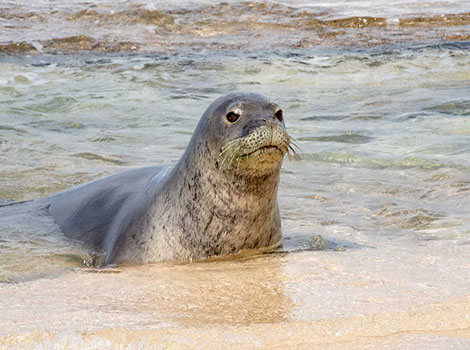
| Attributes | Quick facts |
|---|---|
| Size | 7–7.5 ft (2.1–2.3 m) |
| Weight | 400–600 lbs (180–270 kg) |
| Lifespan | 25–30 years |
| Habitat | Tropical waters, sandy beaches, and coral reefs in the Hawaiian Islands |
| Diet | Carnivorous; feeds on fish, squid, octopus, and crustaceans |
| Social Structure | Solitary, but may gather during breeding or resting |
| Conservation | Endangered |
Fun Fact: The Hawaiian Monk Seal, often called a “living fossil,” is one of only two surviving monk seal species, highlighting its ancient lineage and evolutionary significance.
After examining these mammals, let’s move to reptiles. These cold-blooded animals starting with ‘H’ bring unique evolutionary adaptations that define their survival in diverse terrains.
Reptiles that start with H
Reptiles such as the horned lizard and hawksbill sea turtle showcase incredible traits like camouflage and resilience, vital to thriving in their often challenging habitats.
| Horned Lizard | Hawksbill Sea Turtle | Habu Snake |
| Hognose Snake | Horned Viper | Harlequin Coral Snake |
| Horned Adder | Hook-Nosed Sea Snake |
27. Habu Snake
The Habu snake, also known as Protobothrops flavoviridis or other species in the Protobothrops genus, belongs to the viper family (Viperidae). These snakes grow 4 to 8 feet long, weigh 2 to 6 pounds, and live in tropical forests, grasslands, and rocky terrains across Southeast Asia and Japan’s Ryukyu Islands. Their greenish, brown, or yellowish bodies with dark blotches blend perfectly with their surroundings. Equipped with triangular heads and heat-sensitive pits, they use these features to ambush small animals like birds and mammals, injecting venom to immobilize their prey.
Habu snakes are solitary, mainly active at night, and give live births to independent, venomous young. Though not endangered, their habitats face threats from human activities.
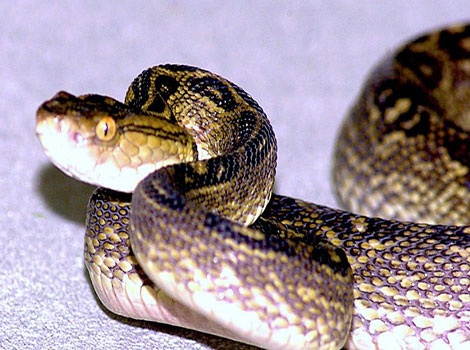
| Attributes | Quick facts |
|---|---|
| Size | 4–8 ft (1.2–2.4 m), depending on species |
| Weight | 2–6 lbs (0.9–2.7 kg) |
| Lifespan | 10–15 years in the wild |
| Habitat | Forests, grasslands, and rocky areas in Southeast Asia and the Ryukyu Islands of Japan |
| Diet | Small mammals, birds, reptiles, and amphibians |
| Social Structure | Solitary |
| Conservation | Least Concern |
Fun fact: The venom of Habu snakes is famously used to make Okinawan liquor, habushu, with the snake preserved inside the bottle—a unique mix of science and tradition!
28. Hognose Snake
The Hognose snake, part of the Heterodon genus, belongs to the Colubrid family (Colubridae). These snakes are 1.5 to 4 feet long and weigh up to 2 pounds. They thrive in grasslands, forests, and sandy areas across North and Central America, particularly in the U.S. and Mexico. With their pig-like upturned snouts, they excel at burrowing. Their colors range from brown and gray to green or orange, often with blotches that help them blend into their surroundings.
Hognose snakes are solitary and active during the day, feeding on toads, reptiles, and small mammals. They use mild venom to subdue prey, but it’s harmless to humans. Known for their dramatic defenses, they may flatten their necks like a cobra or even “play dead” to fool predators.
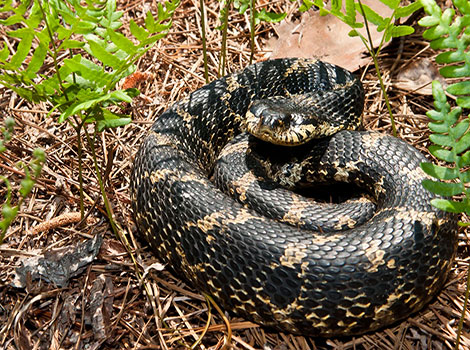
| Attributes | Quick facts |
|---|---|
| Size | 1.5–4 ft (46–122 cm), depending on species |
| Weight | 0.5–2 lbs (0.2–0.9 kg) |
| Lifespan | 10–15 years in the wild; up to 20 years in captivity |
| Habitat | Grasslands, forests, and sandy areas in North and Central America |
| Diet | Amphibians, reptiles, and small mammals |
| Social Structure | Solitary |
| Conservation | Least Concern |
Fun fact: Hognose snakes are master performers! If threatened, they roll onto their backs, stick out their tongues, and pretend to be lifeless—a true reptilian Oscar act!
29. Horned Lizard
The Horned lizard, part of the Phrynosoma genus, belongs to the Spiny Lizard family (Phrynosomatidae). These small reptiles, measuring 2.5 to 5 inches and weighing up to 2 ounces, inhabit deserts, grasslands, and rocky terrains in North and Central America, particularly the southwestern U.S. and Mexico. Their flat, rounded bodies are covered in spiny scales, with head horns adding to their fierce appearance. They are masters of camouflage, blending with the soil to evade predators.
Primarily feeding on ants—especially harvester ants—they use their sticky tongues to catch prey. Active during mornings and late afternoons, Horned lizards prefer to avoid midday heat. These solitary creatures lay clutches of 10–30 eggs in sandy burrows, with hatchlings independent from birth.
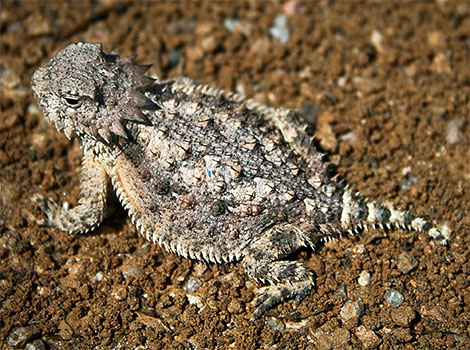
| Attributes | Quick facts |
|---|---|
| Size | 2.5–5 in (6–13 cm), depending on species |
| Weight | 0.5–2 oz (15–60 g) |
| Lifespan | 5–8 years in the wild; up to 10 years in captivity |
| Habitat | Deserts, grasslands, and rocky areas in North and Central America |
| Diet | Primarily ants, but also eats other insects |
| Social Structure | Solitary |
| Conservation | Least Concern |
Fun fact: Horned lizards have one of nature’s wildest defenses—they can squirt blood from their eyes to scare off predators like coyotes. Talk about a startling surprise!
30. Horned Viper
The Horned viper, scientifically known as Cerastes cerastes, is a fascinating member of the Viper family (Viperidae). Measuring 12 to 24 inches in length and weighing up to 0.6 pounds, this slender snake inhabits the hot deserts and rocky terrains of North Africa and the Middle East. Its beige, yellowish, or light brown coloration, combined with keeled scales, allows it to blend seamlessly into sandy environments. Its most distinctive feature is the horn-like scales above its eyes, which give the snake its name.
A solitary ambush predator, the Horned viper feeds on small mammals, birds, and lizards, using its venomous fangs to subdue prey. Primarily nocturnal, it often buries itself under sand or hides beneath rocks to escape extreme heat. Females lay 8–23 eggs, leaving hatchlings to fend for themselves as fully venomous newborns.
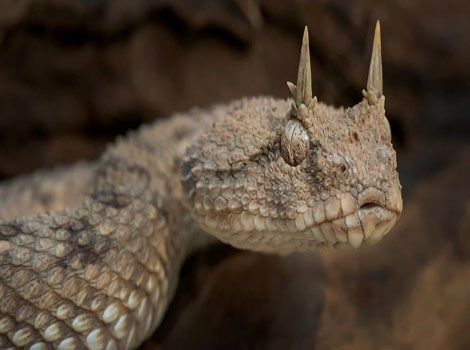
| Attributes | Quick facts |
|---|---|
| Size | 12–24 inches (30–60 cm) |
| Weight | 0.2–0.6 lb (100–300 g) |
| Lifespan | 10–18 years |
| Habitat | Deserts, rocky areas, and semi-arid regions in North Africa and the Middle East |
| Diet | Small mammals, birds, and lizards |
| Social Structure | Solitary |
| Conservation | Least Concern |
Fun fact: The Horned viper uses a unique “sidewinding” motion to glide efficiently across loose desert sands while reducing heat exposure—an impressive desert survival skill!
31. Harlequin Coral Snake
The Harlequin Coral Snake, Micrurus fulvius, is a striking member of the Elapid family (Elapidae). These snakes are slender and elongated, growing 18 to 30 inches long and weighing up to 0.3 pounds. Found in forests, marshes, and sandy areas of the southeastern U.S. and Central America, they thrive in warm, humid climates. Their smooth, shiny scales display vibrant red, yellow, and black bands that warn of their potent neurotoxic venom.
Solitary and secretive, Harlequin Coral Snakes often burrow or hide under leaf litter and logs, hunting small reptiles, amphibians, and even other snakes. Primarily nocturnal, they occasionally emerge during the day in cooler weather. Females lay 3–12 eggs, leaving venomous hatchlings to survive independently from birth.
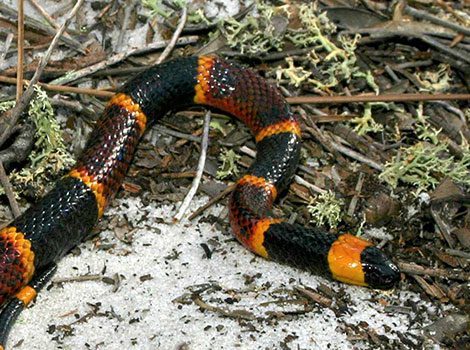
| Attributes | Quick facts |
|---|---|
| Size | 18–30 inches (46–76 cm) |
| Weight | 0.1–0.3 lb (50–140 g) |
| Lifespan | 7–10 years |
| Habitat | Forests, marshes, and sandy areas in the southeastern United States and Central America |
| Diet | Small reptiles, amphibians, and other snakes |
| Social Structure | Solitary |
| Conservation | Least Concern |
Fun fact: These snakes are often mistaken for harmless mimics like the Scarlet Kingsnake. The rhyme “Red touches yellow, kill a fellow; red touches black, friend of Jack” can help identify the venomous Coral Snake!
32. Horned Adder
The Horned Adder, Bitis caudalis, is a small viper from the Viper family (Viperidae), measuring 12 to 16 inches long and weighing up to 1.1 pounds. Native to Southern Africa, it thrives in deserts and savannas of Namibia, Botswana, and South Africa, preferring hot, dry climates. Its sand-colored body with darker patterns and rough, keeled scales provides perfect camouflage in arid terrain. The snake’s defining feature is the horn-like scale above each eye, adding to its cryptic appearance.
An ambush predator, the Horned Adder preys on small mammals, birds, and lizards, using venom to immobilize them. Solitary and mostly nocturnal, it often buries itself in sand, exposing only its eyes and horns to stay hidden. Females give birth to 6–12 live young, which are independent and venomous from birth.
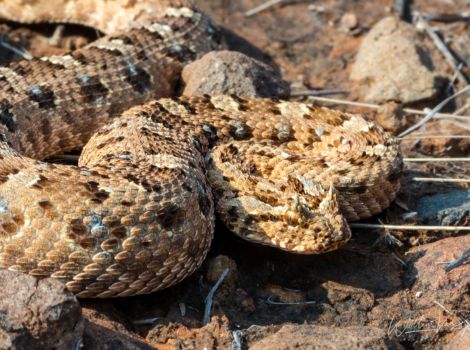
| Attributes | Quick facts |
|---|---|
| Size | 12–16 inches (30–40 cm) |
| Weight | 0.4–1.1 lb (200–500 g) |
| Lifespan | 10–15 years |
| Habitat | Arid and semi-arid regions, including deserts and savannas in southern Africa |
| Diet | Small mammals, lizards, and birds |
| Social Structure | Solitary |
| Conservation | Least Concern |
Fun fact: The Horned Adder can “vanish” into sandy terrain by wriggling into the ground, leaving only its eyes and horns visible—a desert survival magic trick!
33. Hook-Nosed Sea Snake
The Hook-Nosed Sea Snake, Enhydrina schistosa, is a remarkable member of the Elapid family (Elapidae). It measures 3 to 4 feet in length and weighs up to 4.4 pounds. Found in the warm coastal waters of the Indo-Pacific, including Southeast Asia, India, and Australia, this snake thrives in estuaries and river mouths. Its gray, brown, or olive body, sometimes marked with faint bands, is perfectly streamlined for swimming. The snake’s unique hooked snout helps it forage for fish and eggs buried in sediment.
A solitary hunter, the Hook-Nosed Sea Snake uses its potent neurotoxic venom to immobilize prey like fish and fish eggs. Females give birth to 5–25 live young, which are independent and venomous from birth. Despite being highly venomous, these snakes are shy and avoid humans.
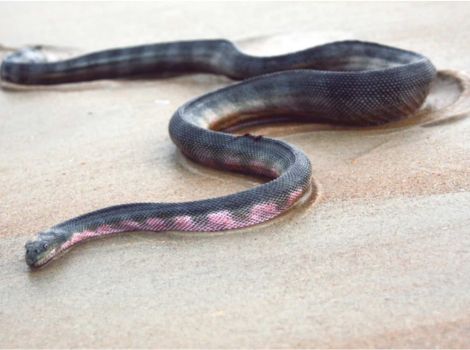
| Attributes | Quick facts |
|---|---|
| Size | 3–4 feet (0.9–1.2 meters) |
| Weight | 2.2–4.4 lb (1–2 kg) |
| Lifespan | 5–10 years |
| Habitat | Coastal waters and estuaries in the Indo-Pacific region |
| Diet | Fish and fish eggs |
| Social Structure | Solitary |
| Conservation | Least Concern |
Fun fact: Among the most venomous sea snakes in the world, the Hook-Nosed Sea Snake’s reclusive behavior means human encounters and fatalities are rare. It’s a powerful predator, yet a peaceful marine dweller!
Shifting from the intriguing reptiles, let’s turn our attention to birds starting with ‘H.’ These feathered creatures captivate with their vibrant appearances and melodious calls.
Birds that start with H
Birds like the heron and hawk highlight the beauty and diversity within avian species. Their varied diets, behaviors, and flight styles contribute to ecosystems worldwide.
| Heron | Harriers | House Finch |
| Hawk | House Wren | Harlequin Duck |
| Hairy Woodpecker | House Martin | Hamerkop Bird |
| Harris Hawk | Hoopoe | Herring Gull |
| Honey Buzzard | Horned Puffin | Hooded Oriole |
| Harpy Eagle | Hawaiian Goose (Nene) | Hyacinth Macaw |
| Humboldt Penguin | Horned Grebe | Hawaiian Crow |
34. Heron
Herons, members of the Ardeidae family, are elegant wading birds found in wetlands, rivers, lakes, and coastal areas worldwide. Depending on the species, they measure 34–55 inches (86–140 cm) in length, weigh 2–6.6 pounds (1–3 kilograms), and have a wingspan of 5–7 feet (1.5–2.1 meters). Their long necks and legs are ideal for shallow waters, while sharp, pointed bills help spear prey. Typically gray, white, or brown, some species display striking plumage during the breeding season.
Herons primarily feed on fish, amphibians, and crustaceans, hunting with slow wades or stillness followed by swift bill thrusts. While solitary during foraging, they nest colonially in heronries near water. Both parents care for chicks, which fledge after 6–7 weeks. Though generally classified as Least Concern, habitat loss and pollution pose localized threats.
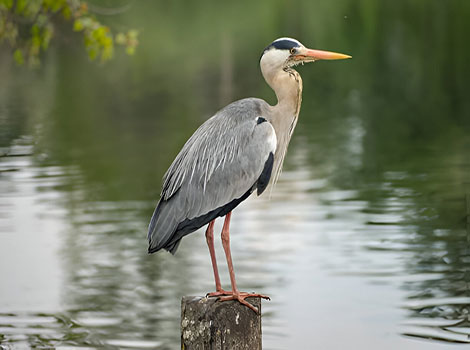
| Attributes | Quick facts |
|---|---|
| Size | 34–55 inches (86–140 cm, varies by species) |
| Weight | 2–6.6 lb (1–3 kg) |
| Lifespan | 15–25 years |
| Habitat | Wetlands, rivers, lakes, and coastal areas worldwide |
| Diet | Fish, amphibians, crustaceans, and small mammals |
| Social Structure | Solitary or colonial during nesting |
| Conservation | Least Concern |
Fun Fact: Herons’ specialized neck vertebrae form an “S” shape, enabling rapid, precise strikes at prey!
35. Harriers
Harriers, agile birds of prey in the Accipitridae family, are known for their adaptability to open habitats like grasslands, wetlands, and marshes worldwide. Measuring 16–24 inches (40–61 cm) in length with a wingspan of 38–48 inches (97–122 cm), they weigh between 0.7–2.3 pounds (300–1,050 grams). Males are light gray or pale brown with white undersides, while females are brown with streaked patterns and a white rump. Their long wings and owl-like facial disk enhance their flight and sound detection during hunts.
Harriers hunt small mammals, birds, and reptiles by gliding low over open areas. Solitary outside breeding seasons, they form pairs to nest on the ground in dense vegetation. Females incubate 4–6 eggs while males provide food, with chicks fledging at 35–40 days. Though listed as Least Concern, habitat loss and pesticides threaten some populations.
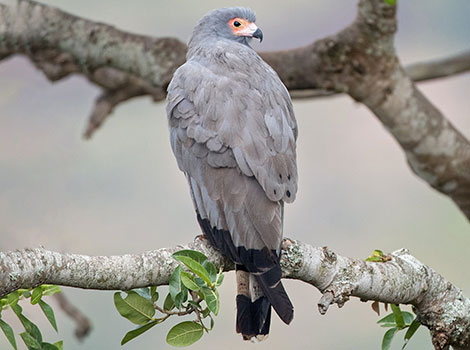
| Attributes | Quick facts |
|---|---|
| Size | 18–24 inches (46–61 cm) |
| Weight | 0.8–2.3 lb (360–1,050 g) |
| Lifespan | 10–20 years |
| Habitat | Forests, savannas, and open woodlands in Africa and parts of Asia |
| Diet | Birds, small mammals, reptiles, and insects |
| Social Structure | Solitary or pairs |
| Conservation | Least Concern |
Fun Fact: Harriers’ owl-like facial disk helps them use both sight and sound to hunt efficiently!
36. House Finch
The House Finch (Haemorhous mexicanus), a member of the Fringillidae family, is a small songbird native to North America. Measuring 5–6 inches (13–15 cm) long and weighing 0.6–0.9 ounces (16–27 grams), it has a wingspan of 8–10 inches (20–25 cm). This adaptable species thrives in urban areas, farmlands, and open woodlands, often nesting in building structures. Males display vibrant red or orange plumage on the head, chest, and rump, while females are brown with streaked underparts. Their conical beaks are perfect for cracking seeds, their primary food source, along with fruits and insects.
House Finches are highly social, forming flocks and actively foraging on the ground or perched on plants. Males sing warbling songs to attract mates, and both parents feed their chicks until fledging at 12–19 days. Despite their stable population, they can be affected by diseases like conjunctivitis in crowded settings.
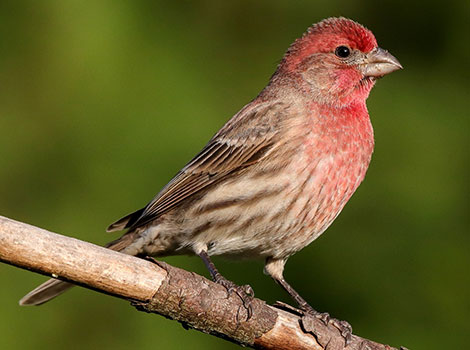
| Attributes | Quick facts |
|---|---|
| Size | 5–6 inches (13–15 cm) |
| Weight | 0.6–0.9 oz (16–27 g) |
| Lifespan | 7–10 years |
| Habitat | Urban areas, farmlands, and open woodlands in North America |
| Diet | Seeds, fruits, and insects |
| Social Structure | Flocks |
| Conservation | Least Concern |
Fun Fact: Originally from the western U.S., House Finches were introduced to the east in the 1940s and have become one of North America’s most widespread songbirds!
37. Hawk
Hawks, members of the Accipitridae family, are agile raptors found in various habitats worldwide, from forests and grasslands to deserts and urban areas. They range in size from 12–27 inches (30–70 cm) in length, with wingspans of 2–4.5 feet (0.6–1.4 meters) and weights of 0.5–4.4 pounds (0.2–2 kilograms). Their plumage varies by species but typically features shades of brown, gray, and white for camouflage. Hawks are known for their hooked beaks, sharp talons, and exceptional eyesight, which aids in spotting prey.
These solitary hunters feed on mammals, birds, reptiles, and insects, with some species specializing in particular prey. Hawks form monogamous pairs during breeding seasons, constructing nests in trees, cliffs, or structures. Both parents care for chicks, which fledge after 4–8 weeks. While most species are of Least Concern, some, like Ridgway’s Hawk, face conservation challenges.
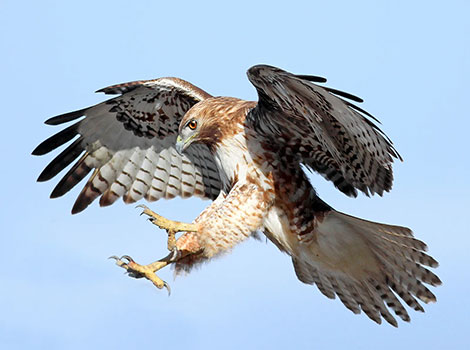
| Attributes | Quick facts |
|---|---|
| Size | 12–27 inches (30–70 cm, varies by species) |
| Weight | 0.5–4.4 lb (0.2–2 kg, varies by species) |
| Lifespan | 10–20 years |
| Habitat | Diverse environments including forests, grasslands, deserts, and urban areas worldwide |
| Diet | Small mammals, birds, reptiles, and insects |
| Social Structure | Solitary or pairs during breeding |
| Conservation | Least Concern |
Fun Fact: Hawks’ vision is eight times sharper than humans, allowing them to spot prey over a mile away!
38. House Wren
The House Wren, a small bird from the Troglodytidae family, is found across the Americas, from Canada to South America. Measuring 4.3–5.1 inches long and weighing up to 0.4 ounces, it has a brown body, buff underparts, and barring on its wings and tail. This tiny bird often holds its tail upright, a hallmark of wrens, and uses its slightly curved bill to forage for insects and spiders in dense vegetation.
Known for its bubbling song, the House Wren is highly territorial and adaptable, thriving in woodlands, gardens, and urban areas. Males build multiple nests in cavities, and females choose one to lay 4–8 eggs. After 12–16 days of incubation, chicks fledge in 15–18 days, with both parents providing care.
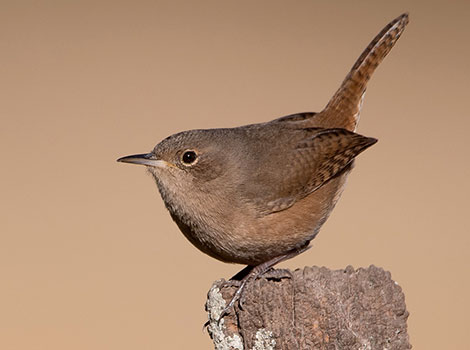
| Attributes | Quick facts |
|---|---|
| Size | 4.3–5.1 inches (11–13 cm) |
| Weight | 0.3–0.4 oz (10–12 g) |
| Lifespan | 7–9 years |
| Habitat | Open woodlands, gardens, and suburban areas in the Americas |
| Diet | Insects, spiders, and small invertebrates |
| Social Structure | Solitary or pairs during breeding season |
| Conservation | Least Concern |
Fun Fact: House Wrens aggressively defend their territory, even removing eggs or young from neighboring nests to eliminate competition for resources!
39. Harlequin Duck
The Harlequin Duck (Histrionicus histrionicus), part of the Anatidae family, thrives in fast-flowing rivers and rocky coastal waters across North America, Greenland, and eastern Russia. Measuring 13–17 inches (33–43 cm) in length and weighing 1–1.6 pounds (450–725 grams), it has a 26-inch (66 cm) wingspan. Males feature striking slate blue plumage with bold white markings and chestnut flanks, while females sport subtler brown tones with white facial spots. Their compact bodies and short wings are perfect for navigating turbulent waters.
Harlequin Ducks forage by diving, feeding on insects, mollusks, crustaceans, and fish. Social outside breeding, they pair up to nest near streams. Females incubate 4–8 eggs, with precocial chicks quickly learning to swim and feed under their mother’s guidance. Though classified as Least Concern, they face risks from habitat disturbances and climate change.
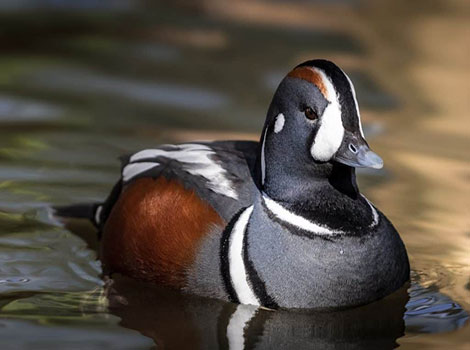
| Attributes | Quick facts |
|---|---|
| Size | 13–17 inches (33–43 cm) |
| Weight | 1–1.6 lb (450–725 g) |
| Lifespan | 12–15 years |
| Habitat | Fast-flowing rivers and rocky coastal waters in North America, Greenland, and eastern Russia |
| Diet | Insects, mollusks, crustaceans, and small fish |
| Social Structure | Small flocks, pairs during breeding season |
| Conservation | Least Concern |
Fun Fact: Named after the theatrical Harlequin, the male’s vibrant colors bring a splash of drama to rugged aquatic habitats!
40. Hairy Woodpecker
The Hairy Woodpecker, a member of the Picidae family, is a medium-sized woodpecker found throughout North America, from Alaska to Central America. Measuring 7.1–10.2 inches in length with a wingspan of 13–16 inches, it features striking black-and-white plumage with a white underside. Males are distinguished by a red patch on the back of the head, absent in females. Its strong, chisel-like bill and bracing tail feathers are perfect for drilling into trees.
Primarily insectivorous, it feeds on beetles, ants, and larvae extracted from wood, supplemented by seeds, nuts, and occasionally sap. Solitary by nature, it drums on trees to communicate and defend its territory. Monogamous pairs excavate tree trunks for nests, sharing incubation and feeding duties for their 3–6 chicks, which fledge after 28–30 days.
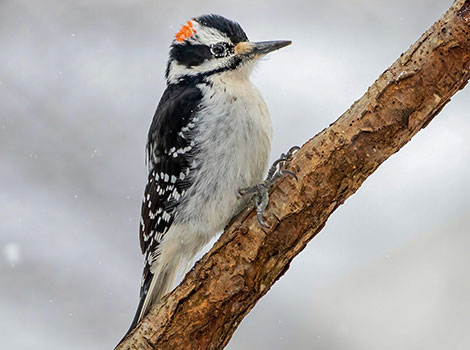
| Attributes | Quick facts |
|---|---|
| Size | 7.1–10.2 inches (18–26 cm) |
| Weight | 1.4–3.4 oz (40–95 g) |
| Lifespan | 4–15 years |
| Habitat | Forests, woodlands, and suburban areas across North America |
| Diet | Insects, seeds, and tree sap |
| Social Structure | Solitary or pairs during breeding season |
| Conservation | Least Concern |
Fun Fact: The Hairy Woodpecker’s tongue extends far beyond its beak, helping it reach insects deep inside tree crevices—a remarkable adaptation for foraging!
41. House Martin
The House Martin, a small bird from the Hirundinidae family, is a familiar sight in towns, villages, and open countryside across Europe, Asia, and North Africa. Measuring 5–6 inches in length and weighing up to 0.7 ounces, it is known for its glossy blue-black upperparts, white underparts, and distinctive white rump. With a short, forked tail and pointed wings, it is highly agile in flight, perfectly adapted for catching flying insects like flies and mosquitoes.
These birds are highly social, building mud nests in colonies on vertical surfaces such as building eaves or cliffs. Migratory by nature, they travel vast distances between breeding grounds and wintering areas in sub-Saharan Africa. Both parents construct nests, incubate 3–5 eggs, and feed their chicks until they fledge.
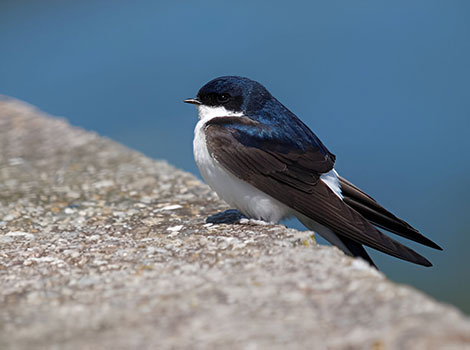
| Attributes | Quick facts |
|---|---|
| Size | 5–6 inches (12–15 cm) |
| Weight | 0.6–0.7 oz (16–19 g) |
| Lifespan | 2–5 years |
| Habitat | Open countryside, towns, and villages with access to mud for nesting in Europe, Asia, and North Africa |
| Diet | Flying insects |
| Social Structure | Colonial; nests in groups |
| Conservation | Least Concern |
Fun Fact: House Martins are master builders, using mud pellets to create their nests and often returning to the same nest each year to repair and reuse it!
42. Hamerkop Bird
The Hamerkop, the sole species in the Scopidae family, is a medium-sized wading bird found in wetlands, rivers, and marshes across sub-Saharan Africa and Madagascar. Measuring 20–24 inches and weighing up to 1.2 pounds, it is recognizable by its brown plumage and hammer-shaped head, complete with a crest. Equipped with long legs and a curved bill, it forages in shallow waters for fish, amphibians, crustaceans, and insects.
Hamerkops are known for their enormous nests, often weighing over 100 pounds, made of sticks and mud. Monogamous pairs build and reuse these domed structures for years, laying 3–7 eggs that both parents incubate. They actively care for their chicks until they fledge.
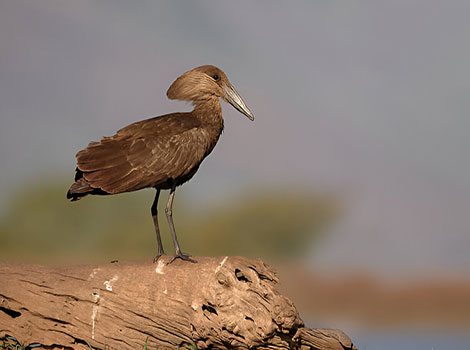
| Attributes | Quick facts |
|---|---|
| Size | 20–24 inches (50–61 cm) |
| Weight | 0.88–1.2 lb (400–550 g) |
| Lifespan | 20–30 years |
| Habitat | Wetlands, rivers, and lakes in sub-Saharan Africa and Madagascar |
| Diet | Fish, amphibians, crustaceans, and insects |
| Social Structure | Solitary or pairs; sometimes seen in groups around food sources |
| Conservation | Least Concern |
Fun Fact: Hamerkop nests are so sturdy that other creatures, like owls, snakes, and small mammals, often repurpose them for shelter, showcasing their impressive construction skills!
43. Harris Hawk
The Harris Hawk, a sociable bird of prey from the Accipitridae family, measures 18–24 inches in length with a wingspan of up to 47 inches and weighs 1.5–3.5 pounds. Native to deserts, scrublands, and woodlands in the Americas, it thrives in open habitats with scattered trees or shrubs. Its dark brown body, chestnut-red shoulders and thighs, and white-tipped tail make it strikingly recognizable. Long legs and a hooked bill make it a skilled predator.
Unusual for raptors, Harris Hawks live and hunt cooperatively in groups, working together to flush out prey like rabbits, rodents, and lizards. They even perch in stacks, a behavior called “stacking.” Nests are built in trees, cacti, or cliffs, and both parents and helpers feed and protect the chicks, boosting their survival.
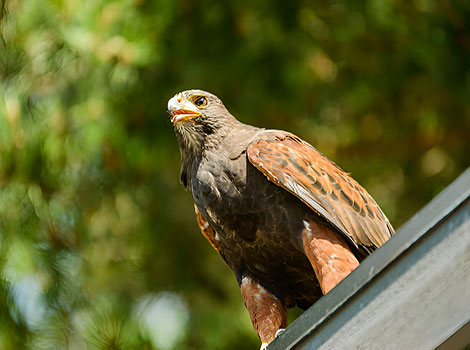
| Attributes | Quick facts |
|---|---|
| Size | 18–24 inches (46–60 cm) |
| Weight | 1.5–3.5 lb (0.7–1.6 kg) |
| Lifespan | 10–20 years |
| Habitat | Deserts, scrublands, and woodlands in the Americas (primarily southwestern U.S. to South America) |
| Diet | Small mammals, birds, and reptiles |
| Social Structure | Highly social; hunts in cooperative groups |
| Conservation | Least Concern |
Fun Fact: Renowned for their intelligence and teamwork, Harris Hawks are a top choice in falconry, admired for their trainability and cooperative hunting skills!
44. Hoopoe
The Hoopoe, a unique bird in the Upupidae family, measures 10–12 inches long with a wingspan of up to 19 inches and weighs 1.6–3.1 ounces. Found across Europe, Asia, and Africa, it inhabits open woodlands, savannas, and cultivated areas, favoring places with sparse vegetation and cavities for nesting. Its cinnamon-orange body, black-and-white striped wings and tail, and prominent crest of feathers make it unmistakable. A long, curved bill helps it dig for insects and small invertebrates like beetles and worms.
Hoopoes are primarily solitary, known for their undulating flight that resembles a butterfly’s. During breeding, females lay 5–9 eggs in cavities, with both parents feeding the chicks until they fledge after 26–30 days. Nestlings emit a foul-smelling secretion to deter predators.
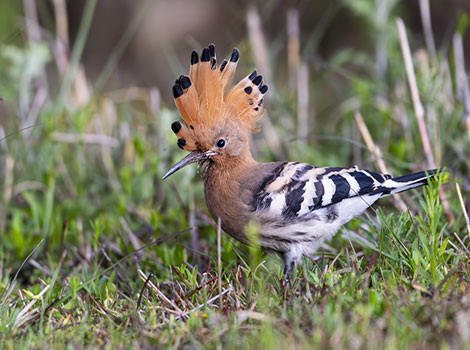
| Attributes | Quick facts |
|---|---|
| Size | 10–12 inches (25–32 cm) |
| Weight | 1.6–3.1 oz (45–87 g) |
| Lifespan | 10–15 years |
| Habitat | Open woodlands, grasslands, and savannas in Europe, Asia, and Africa |
| Diet | Insects, larvae, and small invertebrates |
| Social Structure | Solitary or pairs |
| Conservation | Least Concern |
Fun Fact: The Hoopoe’s name comes from its iconic “hoo-poo” call, a distinctive sound often heard during the breeding season!
45. Herring Gull
The Herring Gull, a widespread member of the Laridae family, measures 22–26 inches in length with a wingspan of up to 58 inches and weighs up to 3.6 pounds. Found throughout the Northern Hemisphere, it thrives in coastal areas, inland waterways, and urban settings. Its white body, light gray wings with black tips, and pink legs make it easily recognizable, along with its yellow bill featuring a red spot that chicks use as a feeding cue.
Omnivorous and opportunistic, Herring Gulls feed on fish, invertebrates, carrion, and human scraps, often scavenging at landfills or stealing from other birds. Highly intelligent, they use tools like dropping shellfish onto rocks to access food. They nest in colonies, laying 2–4 eggs incubated by both parents, who also care for the chicks until they fledge at 6–7 weeks.
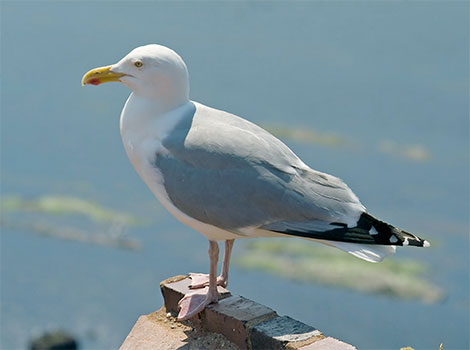
| Attributes | Quick facts |
|---|---|
| Size | 22–26 inches (56–66 cm) |
| Weight | 1.5–3.6 lb (680–1,600 g) |
| Lifespan | 10–30 years |
| Habitat | Coastal areas, inland waterways, and urban regions in the Northern Hemisphere |
| Diet | Fish, invertebrates, carrion, and human scraps |
| Social Structure | Colonial during breeding; flocks otherwise |
| Conservation | Least Concern |
Fun Fact: Herring Gulls are clever problem-solvers, known to open food packaging and mimic other animals’ calls to secure a meal!
46. Honey Buzzard
The Honey Buzzard, a member of the Accipitridae family, is a woodland raptor found across Europe, Asia, and parts of Africa. Measuring 21–23 inches in length with a wingspan of 50–60 inches, it weighs up to 2.2 pounds. Its mottled brown plumage, long neck, and small head give it a pigeon-like appearance in flight. Scaly, sting-resistant skin around its eyes and bill protects it when raiding bee and wasp nests.
Specializing in feeding on bees, wasps, larvae, and honeycomb, the Honey Buzzard also eats small birds, reptiles, and amphibians. Solitary or paired during the breeding season, it migrates between its breeding grounds in Europe and Asia and wintering areas in Africa, soaring on thermal currents. Monogamous pairs raise 1–3 chicks in tree nests, feeding them insect larvae and prey until they fledge.

| Attributes | Quick facts |
|---|---|
| Size | 21–23 inches (53–59 cm) |
| Weight | 1.1–2.2 lb (500–1,000 g) |
| Lifespan | 10–15 years |
| Habitat | Woodlands and forests in Europe, Asia, and parts of Africa |
| Diet | Bees, wasps, larvae, and honeycomb; occasionally small birds and reptiles |
| Social Structure | Solitary or pairs |
| Conservation | Least Concern |
Fun Fact: Immune to stings, the Honey Buzzard fearlessly raids hives, making it one of the few birds that thrives on honeycomb and larvae!
47. Horned Puffin
The Horned Puffin, a seabird in the Alcidae family, measures 15–16 inches in length and weighs up to 1.4 pounds. Native to the North Pacific, it inhabits coastal cliffs and open seas from Alaska to Siberia. With a black back and head, white underparts, and a striking orange bill marked with yellow and red during the breeding season, it also features small horn-like projections above its eyes, inspiring its name. Its compact body and short wings are ideal for diving and swimming.
Horned Puffins feed on fish, squid, and crustaceans, using their powerful wings to “fly” underwater, reaching depths of up to 100 feet. During the breeding season, they nest in colonies on rocky cliffs, laying a single egg. Both parents incubate the egg and feed the chick small fish until it fledges at 6–7 weeks old.
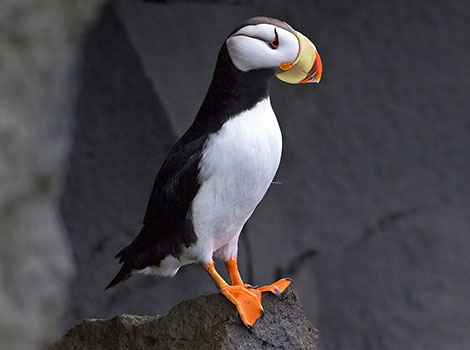
| Attributes | Quick facts |
|---|---|
| Size | 15–16 inches (38–41 cm) |
| Weight | 1–1.4 lb (450–635 g) |
| Lifespan | 20–25 years |
| Habitat | Coastal cliffs and open seas in the North Pacific Ocean |
| Diet | Fish, squid, and crustaceans |
| Social Structure | Colonial during breeding; solitary at sea |
| Conservation | Least Concern |
Fun Fact: Horned Puffins can carry multiple fish crosswise in their beaks, aided by spines on their tongue and palate, maximizing efficiency when feeding their chicks!
48. Hooded Oriole
The Hooded Oriole, a vibrant member of the Icteridae family, measures 7–8 inches in length and weighs up to 1.1 ounces. Native to the southwestern U.S., Mexico, and Central America, it thrives in open woodlands, palm groves, and suburban areas. Males boast bright yellow to orange bodies with black faces and wings, while females are olive-yellow with grayish wings. Their slender, curved bills are perfect for extracting nectar and catching insects.
These agile birds often hang upside down to access nectar or insects in hard-to-reach spots. Solitary during breeding, they weave intricate hanging nests in palm fronds, laying 3–5 eggs. Both parents feed the chicks, which fledge 14–17 days after hatching.
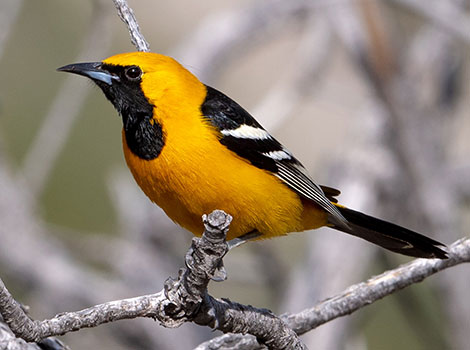
| Attributes | Quick facts |
|---|---|
| Size | 7–8 inches (18–20 cm) |
| Weight | 0.8–1.1 oz (23–31 g) |
| Lifespan | 6–10 years |
| Habitat | Open woodlands, palm groves, and suburban areas in the southwestern United States, Mexico, and Central America |
| Diet | Nectar, fruit, and insects |
| Social Structure | Solitary or in pairs during breeding; small flocks outside the breeding season |
| Conservation | Least Concern |
Fun Fact: Nicknamed “palm-leaf weavers,” Hooded Orioles stitch the edges of palm leaves to create unique, hanging pouch nests!
49. Harpy Eagle
The Harpy Eagle (Harpia harpyja), a member of the Accipitridae family, is a powerful raptor inhabiting tropical rainforests from southern Mexico to northern Argentina. Measuring 35–41 inches (89–105 cm) in length and weighing 9–20 pounds (4–9 kilograms), it boasts a wingspan of 6–7.5 feet (183–224 cm). Its striking black and white plumage is complemented by a gray head with a double crest. With robust legs and enormous talons, it is adapted for capturing prey like monkeys and sloths, often ambushing them from high perches.
Typically solitary, Harpy Eagles are territorial, spending hours scanning for prey from tall trees. Monogamous pairs breed every 2–3 years, building large nests where they raise one chick that may stay dependent for up to two years. Despite being classified as Near Threatened, habitat loss and hunting continue to impact their populations.
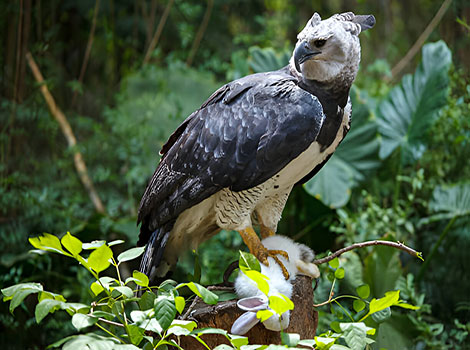
| Attributes | Quick facts |
|---|---|
| Size | 35–41 inches (89–105 cm) |
| Weight | 9–20 lb (4–9 kg) |
| Lifespan | 25–35 years |
| Habitat | Tropical rainforests in Central and South America |
| Diet | Monkeys, sloths, and other medium-sized mammals |
| Social Structure | Solitary or pairs |
| Conservation | Near Threatened |
Fun Fact: Harpy Eagles’ talons, reaching up to 5 inches long, are larger than a grizzly bear’s claws!
50. Hawaiian Goose (Nene)
The Hawaiian Goose (Nēnē, Branta sandvicensis), a member of the Anatidae family, is a unique species native to the Hawaiian Islands. Measuring 16–26 inches (41–66 cm) long and weighing 3.5–6.5 pounds (1.6–3 kilograms), it has a wingspan of about 3 feet (91 cm). This goose thrives in grasslands, shrublands, and lava plains, preferring open environments with low vegetation. Its buff-colored body, black head, and distinctive streaked neck make it easily recognizable, while its partially webbed feet are adapted for walking on rugged volcanic terrain.
Nēnēs are herbivores, foraging during the day on grasses, berries, and flowers. They live in monogamous pairs or small groups and are non-migratory, staying on the islands year-round. Conservation efforts have helped this Vulnerable species recover from near extinction caused by habitat loss and predation by introduced species.
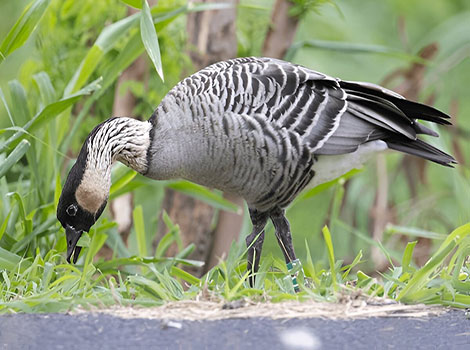
| Attributes | Quick facts |
|---|---|
| Size | 35–41 inches (89–105 cm) |
| Weight | 9–20 lb (4–9 kg) |
| Lifespan | 25–35 years |
| Habitat | Tropical rainforests in Central and South America |
| Diet | Monkeys, sloths, and other medium-sized mammals |
| Social Structure | Solitary or pairs |
| Conservation | Near Threatened |
Fun Fact: The Nēnē, Hawaii’s state bird, is one of the rarest geese worldwide, symbolizing conservation success!
51. Hyacinth Macaw
The Hyacinth Macaw (Anodorhynchus hyacinthinus) is a remarkable member of the Psittacidae family, renowned for its size and vivid coloration. Measuring 39–42 inches (100–107 cm) long, it is the largest flying parrot, weighing between 2.6–3.7 pounds (1.2–1.7 kilograms) with a wingspan of 48–60 inches (122–152 cm). Found in Brazil, Paraguay, and Bolivia, this species thrives in grasslands, swamps, and forests, especially near palm-rich savannas. Its cobalt-blue feathers and yellow eye patches make it a visual marvel, while its strong beak easily cracks tough palm nuts.
Social and vocal, Hyacinth Macaws often forage in pairs or small groups, feeding mainly on palm nuts, fruits, and seeds. Their monogamous bonds and nurturing nature ensure dedicated care for chicks in tree cavity nests. Despite these adaptive traits, habitat loss and illegal trade have led to their Vulnerable status.
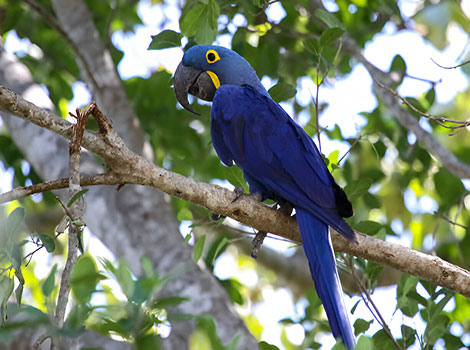
| Attributes | Quick facts |
|---|---|
| Size | 39–42 inches (100–107 cm) |
| Weight | 2.6–3.7 lb (1.2–1.7 kg) |
| Lifespan | 50–70 years |
| Habitat | Grasslands, swamps, and forests in central and eastern South America |
| Diet | Nuts (especially palm nuts), fruits, and seeds |
| Social Structure | Pairs or small groups |
| Conservation | Vulnerable |
Fun Fact: This macaw’s beak is so strong, it can break Brazil nuts, which most animals can’t!
52. Humboldt Penguin
The Humboldt Penguin, a species in the Spheniscidae family, stands 22–28 inches tall and weighs 8–13 pounds. Native to the rocky coasts of Peru and Chile, it thrives in regions influenced by the nutrient-rich Humboldt Current, which supports its fish-based diet of anchovies, sardines, and crustaceans. Black-and-white coloration, with a distinctive black chest band and a white face border, provides camouflage in water. Pink skin patches near its bill aid in thermoregulation, and its flipper-like wings make it an agile swimmer, capable of diving up to 200 feet.
Social and vocal, Humboldt Penguins live in large colonies. Monogamous pairs breed year-round, building nests in burrows or guano deposits. Both parents share incubation duties for two eggs, feeding chicks regurgitated food until fledging at 70–90 days.
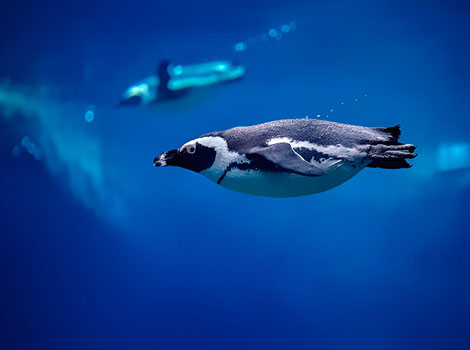
| Attributes | Quick facts |
|---|---|
| Size | 22–28 inches (56–70 cm) |
| Weight | 8–13 lb (3.6–5.9 kg) |
| Lifespan | 15–20 years (wild), up to 30 years (captivity) |
| Habitat | Coastal areas and rocky shores in Peru and Chile |
| Diet | Fish, squid, and crustaceans |
| Social Structure | Colonies |
| Conservation | Vulnerable |
Fun Fact: Humboldt Penguins rely on the cold Humboldt Current not just for food but to regulate their body temperature in Peru and Chile’s warm climates!
53. Horned Grebe
The Horned Grebe, a striking waterbird in the Podicipedidae family, measures 12–15 inches in length with a wingspan of about 24 inches and weighs up to 1.5 pounds. It breeds in freshwater lakes and marshes across North America, Europe, and Asia and winters in coastal waters. During breeding, its black head and golden “horns,” along with a reddish-brown neck, create a bold appearance, while non-breeding plumage is gray with a white face and neck. Its lobed toes and streamlined body make it an adept swimmer and diver.
Horned Grebes dive to catch fish, crustaceans, and insects. Breeding pairs perform intricate courtship displays, including synchronized swimming. They build floating vegetation nests, laying 3–6 eggs, which both parents incubate. Chicks are precocial, often riding on their parents’ backs for warmth and safety.
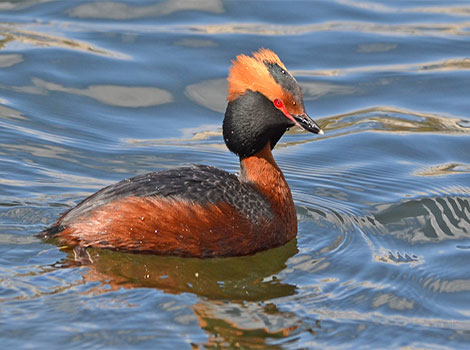
| Attributes | Quick facts |
|---|---|
| Size | 12–15 inches (31–38 cm) |
| Weight | 0.7–1.5 lb (300–700 g) |
| Lifespan | 10–15 years |
| Habitat | Freshwater lakes, ponds, and marshes during breeding; coastal waters in winter |
| Diet | Fish, crustaceans, and aquatic insects |
| Social Structure | Solitary or small groups during migration |
| Conservation | Vulnerable |
Fun Fact: Horned Grebes consume their own feathers and feed them to chicks to protect their stomachs from sharp fish bones!
54. Hawaiian Crow
The Hawaiian Crow, or ʻAlalā, is a critically endangered member of the Corvidae family, measuring 18–20 inches in length and weighing up to 1.2 pounds. Historically found in Hawaiian forests, it is now restricted to conservation areas as part of reintroduction efforts. This intelligent bird has black plumage with a slight brownish tint under sunlight, a strong, curved bill for diverse feeding, and long legs suited for navigating dense foliage.
Omnivorous, it feeds on fruits, insects, small animals, and carrion, often using tools like sticks to extract food from crevices. Social and monogamous, it forms pairs or small groups that communicate through varied vocalizations. Pairs build cup-shaped nests in tall trees, with females laying 3–5 eggs and both parents caring for chicks until they fledge.
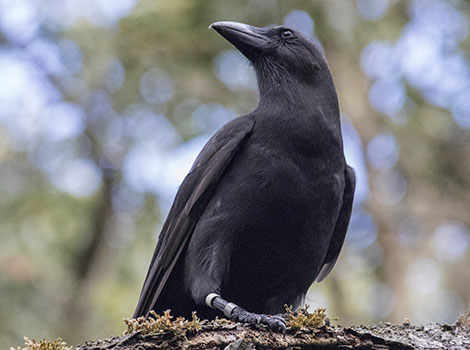
| Attributes | Quick facts |
|---|---|
| Size | 18–20 inches (46–51 cm) |
| Weight | 1–1.2 lb (450–560 g) |
| Lifespan | 16–20 years (in the wild) |
| Habitat | Forested areas of Hawaii (currently restricted to conservation areas) |
| Diet | Fruits, insects, small animals, and carrion |
| Social Structure | Pairs or small family groups |
| Conservation | Critically Endangered |
Fun Fact: Revered in Hawaiian culture, the ʻAlalā was seen as a sacred messenger between humans and the gods, symbolizing its deep cultural significance.
As we leave the skies filled with birds, we dive underwater to explore fish that start with ‘H.’ These aquatic creatures exhibit fascinating adaptations to their watery worlds.
Fish that start with H
Fish such as the hammerhead shark and haddock are extraordinary aquatic species. From predators to staple food sources, they play essential roles in marine ecosystems.
| Hardhead Catfish | Horn Shark | Horse Mackerel |
| Hairy Frogfish | Herring | Hogfish |
| Hake | Hagfish | Halibut |
| Haddock | Hammerhead Shark | Humphead Wrasse |
55. Hardhead Catfish
The Hardhead Catfish, part of the Ariidae family, measures 12–28 inches in length and can weigh up to 12 pounds. Found in the western Atlantic and Gulf of Mexico, it inhabits coastal waters, estuaries, and bays with sandy or muddy bottoms. Its grayish-silver back fades to a white belly, while its broad, flat head features prominent barbels that detect food in murky waters. Equipped with sharp dorsal and pectoral spines, it can inflict painful wounds if mishandled.
Feeding on crustaceans, small fish, and detritus, this catfish scavenges along the seabed, often foraging alone or in small groups. During spring and summer, males incubate eggs and juveniles in their mouths, protecting them until they can survive on their own.
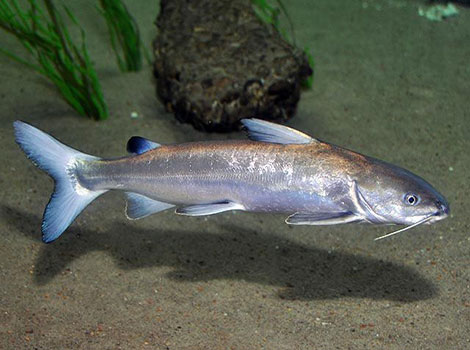
| Attributes | Quick facts |
|---|---|
| Size | 12–28 inches (30–71 cm) |
| Weight | 1–12 lb (0.5–5.4 kg) |
| Lifespan | 5–8 years |
| Habitat | Coastal waters, estuaries, and bays in the western Atlantic and Gulf of Mexico |
| Diet | Crustaceans, small fish, and detritus |
| Social Structure | Small groups or solitary |
| Conservation | Least Concern |
Fun Fact: The Hardhead Catfish creates sounds by rubbing its pectoral fins against its body, a unique behavior used for defense and communication!
56. Horn Shark
The Horn Shark, a member of the Heterodontidae family, is a small shark measuring 3–4 feet in length and weighing up to 24 pounds. Native to the eastern Pacific Ocean, it inhabits coastal waters, rocky reefs, and kelp forests off California and Mexico, favoring depths of 8–150 feet. Its brownish-gray body, adorned with small dark spots, provides effective camouflage. The shark is easily recognized by horn-like ridges above its eyes, a blunt head, and sharp teeth adapted for crushing shells.
A nocturnal predator, the Horn Shark feeds on crustaceans, mollusks, and small fish, using its powerful jaws to crush hard-shelled prey like crabs and sea urchins. Females lay spiral-shaped egg cases, wedged into rocky crevices for safety, leaving juveniles to develop independently after hatching.
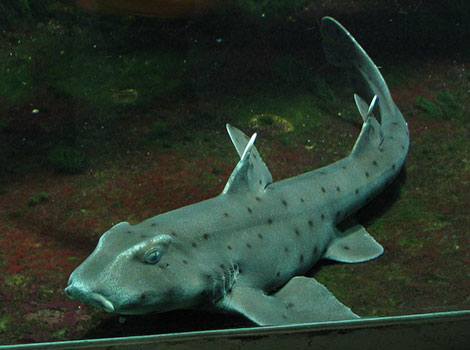
| Attributes | Quick facts |
|---|---|
| Size | 3–4 feet (0.9–1.2 meters) |
| Weight | 22–24 lb (10–11 kg) |
| Lifespan | 20–25 years |
| Habitat | Coastal waters, rocky reefs, and kelp forests in the eastern Pacific Ocean |
| Diet | Crustaceans, mollusks, and small fish |
| Social Structure | Solitary |
| Conservation | Least Concern |
Fun Fact: The Horn Shark’s dorsal fin spines deter predators, while its unique spiral egg cases protect embryos, ensuring their survival in the wild!
57. Horse Mackerel
The Horse Mackerel, a member of the Carangidae family, measures 12–24 inches in length and weighs up to 4 pounds. Found in temperate and tropical oceans worldwide, it inhabits depths from the surface to around 600 feet. Its silvery body, with a bluish or greenish back and pale underside, is streamlined for fast swimming. Equipped with a forked tail, sharp fins, and a scaled lateral line reinforced with scutes, this fish is built for agility and protection.
Horse Mackerel feed on plankton, small fish, and crustaceans, forming dense schools for safety and efficient foraging. Highly migratory, they travel long distances to find food and breeding grounds. During spawning, eggs are released and fertilized in open water, with larvae drifting in plankton until developing into juveniles.
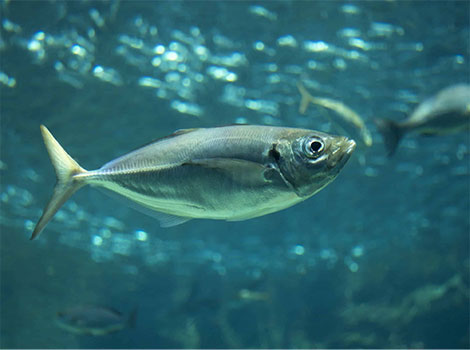
| Attributes | Quick facts |
|---|---|
| Size | 12–24 inches (30–60 cm) |
| Weight | 1–4 lb (0.5–1.8 kg) |
| Lifespan | 7–15 years |
| Habitat | Coastal and offshore waters in temperate and tropical oceans |
| Diet | Plankton, small fish, and crustaceans |
| Social Structure | Schools |
| Conservation | Least Concern |
Fun Fact: Horse Mackerel are swift swimmers, reaching speeds of up to 50 km/h (31 mph), making them challenging to catch for predators and fishermen!
58. Hairy Frogfish
The Hairy Frogfish, a member of the Antennariidae family, is a fascinating marine predator measuring 4–12 inches in length and weighing up to 2 pounds. Found in tropical and subtropical oceans, it inhabits coral reefs, sandy bottoms, and rocky areas at depths of up to 330 feet. Its coloration varies widely, from orange and yellow to green, brown, or black, helping it blend seamlessly into its surroundings. Hair-like appendages further enhance its camouflage, resembling algae or coral, while a lure-like appendage on its head (esca) attracts prey.
An ambush predator, the Hairy Frogfish uses its powerful suction ability to swallow prey as large as itself. It remains solitary and sedentary, “walking” along the seafloor with its pectoral fins. During reproduction, females release eggs in gelatinous masses that float until hatching.
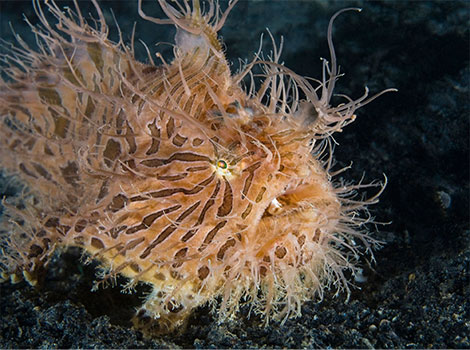
| Attributes | Quick facts |
|---|---|
| Size | 4–12 inches (10–30 cm) |
| Weight | 0.5–2 lb (0.2–0.9 kg) |
| Lifespan | 10–20 years |
| Habitat | Tropical and subtropical oceans, near coral reefs and sandy bottoms |
| Diet | Fish and small crustaceans (ambush predator) |
| Social Structure | Solitary |
| Conservation | Least Concern |
Fun Fact: Hairy Frogfish “walk” on the ocean floor with their fins, making them some of the most unique movers in the underwater world!
59. Herring
Herring, part of the Clupeidae family, are small, silvery fish measuring 10–18 inches and weighing up to 1.5 pounds. They inhabit coastal and offshore waters of the Atlantic and Pacific Oceans, thriving in temperate, shallow waters. With a bluish-green back and streamlined body, they camouflage effectively and swim efficiently using their deeply forked tails. Their large schools shimmer in the water, confusing predators.
Feeding on plankton, small crustaceans, and fish larvae, Herring use gill rakers to filter tiny prey from the water. Migratory and highly social, they move between feeding, spawning, and overwintering areas, spawning in shallow waters where females release up to 50,000 eggs that adhere to the seabed. The larvae grow independently in plankton-rich waters.

| Attributes | Quick facts |
|---|---|
| Size | 10–18 inches (25–46 cm) |
| Weight | 0.5–1.5 lb (0.2–0.7 kg) |
| Lifespan | 12–20 years |
| Habitat | Coastal and offshore waters in the Atlantic and Pacific Oceans |
| Diet | Plankton, small crustaceans, and fish larvae |
| Social Structure | Large schools |
| Conservation | Least Concern |
Fun Fact: Herring “talk” by releasing air bursts from their swim bladders, possibly to communicate and maintain cohesion in their massive schools!
60. Hogfish
The Hogfish, part of the Labridae family, is a striking reef dweller found in the western Atlantic, Gulf of Mexico, and Caribbean. Measuring 12–36 inches and weighing up to 24 pounds, it inhabits coral reefs and rocky bottoms at depths of 10–100 feet, often near sandy areas. Its reddish to pinkish body features darker back tones and lighter bellies, with males displaying more vivid colors. A prominent pig-like snout and long dorsal fin spines make this fish easily recognizable.
Feeding on mollusks, crustaceans, and small fish, the Hogfish uses its strong jaws to crush shells. It lives in harems led by a dominant male, which defends the group and ensures reproduction. As protogynous hermaphrodites, they begin life as females, with some transitioning to males. Eggs are released in open water, where they develop independently.
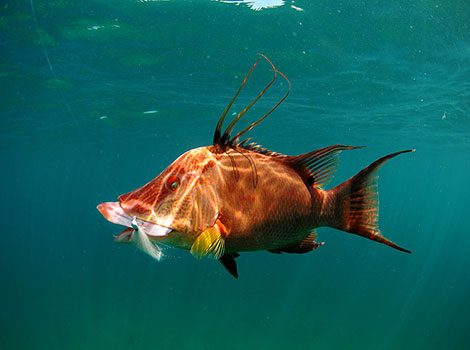
| Attributes | Quick facts |
|---|---|
| Size | 12–36 inches (30–91 cm) |
| Weight | 2–24 lb (0.9–10.9 kg) |
| Lifespan | 10–20 years |
| Habitat | Coral reefs and rocky bottoms in the western Atlantic Ocean and Gulf of Mexico |
| Diet | Mollusks, crustaceans, and small fish |
| Social Structure | Small harems led by a dominant male |
| Conservation | Least Concern |
Fun Fact: The Hogfish earns its name from its pig-like snout, which it uses to root in the sand for food, much like a hog searching for truffles!
61. Hake
Hake, part of the Merlucciidae family, is a commercially important fish found in the Atlantic and Pacific Oceans. Measuring 12–24 inches and weighing up to 5 pounds, it inhabits deep coastal and offshore waters at depths of 200–1,000 meters. Its silvery-gray body, with a darker back and slender shape, provides excellent camouflage in the marine environment. Large eyes adapted to low light and sharp teeth make it an effective predator of small fish, crustaceans, and squid.
Hake form schools, especially during migration and spawning, and exhibit vertical migration—feeding in shallower waters at night and retreating to the depths by day. They spawn seasonally in deep waters, with eggs drifting freely until maturity.
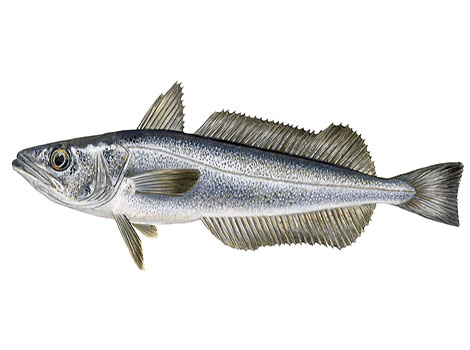
| Attributes | Quick facts |
|---|---|
| Size | 12–24 inches (30–60 cm) |
| Weight | 1–5 lb (0.5–2.3 kg) |
| Lifespan | 10–20 years |
| Habitat | Deep coastal and offshore waters in the Atlantic and Pacific Oceans |
| Diet | Small fish, crustaceans, and squid |
| Social Structure | Schools |
| Conservation | Least Concern |
Fun Fact: Hake is a culinary favorite, prized for its flaky texture and mild flavor, making it a staple in global cuisines!
62. Hagfish
Hagfish, members of the Myxinidae family, are jawless, eel-like fish measuring 16–40 inches and weighing up to 2.3 pounds. They inhabit deep-sea floors in temperate and cold oceans worldwide, burrowing into soft sediment at depths of 100–3,000 feet. Typically pinkish, gray, or brown, their long, cylindrical bodies lack jaws and scales but feature slime glands that produce copious mucus for defense. Around their mouths, barbels help detect food.
As scavengers, Hagfish burrow into carcasses like dead fish and whales or feed on small invertebrates, rasping flesh with their toothed, tongue-like structure. Nocturnal and mostly solitary, they may gather in small groups to feed on large carcasses. They lay tough-shelled eggs, with hatchlings independent from birth.
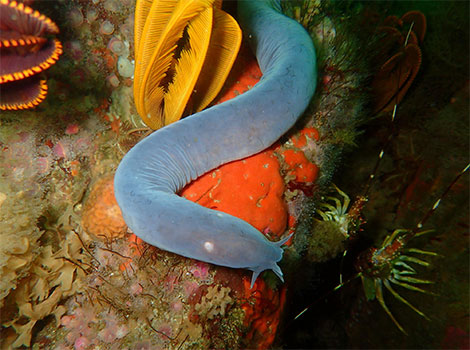
| Attributes | Quick facts |
|---|---|
| Size | 16–40 inches (40–100 cm) |
| Weight | 0.5–2.3 lb (0.2–1 kg) |
| Lifespan | 40+ years (estimated) |
| Habitat | Deep-sea floors in temperate and cold oceans worldwide |
| Diet | Carrion and small invertebrates |
| Social Structure | Solitary or small groups |
| Conservation | Least Concern |
Fun Fact: Known as “slime eels,” Hagfish can produce enough mucus to fill a bucket in seconds, deterring predators by clogging their gills!
63. Halibut
Halibut, part of the Pleuronectidae family, are remarkable flatfish known for their size, ranging from 4–8 feet and weighing up to 500 pounds. Found in the North Atlantic and North Pacific Oceans, they inhabit deep waters from 50 to 2,000 feet, preferring sandy or muddy bottoms. Their dark tops and white undersides provide excellent camouflage, and both eyes are positioned on one side of their diamond-shaped bodies, a unique adaptation for life on the seafloor.
These solitary predators feed on fish like cod and herring, as well as squid and crustaceans, ambushing prey with swift strikes. Spawning occurs in winter, with females releasing millions of eggs that drift until larvae settle. Halibut migrate horizontally and vertically, adjusting to food availability and seasonal changes.
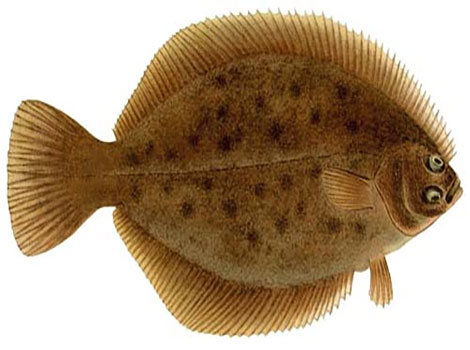
| Attributes | Quick facts |
|---|---|
| Size | 4–8 feet (1.2–2.4 meters) |
| Weight | 50–500 lb (23–227 kg) |
| Lifespan | 25–55 years |
| Habitat | Deep coastal and offshore waters in the North Atlantic and North Pacific Oceans |
| Diet | Fish, squid, and crustaceans |
| Social Structure | Solitary |
| Conservation | Least Concern |
Fun Fact: Halibut experience a dramatic transformation during development, with one eye migrating to the same side of the head as they become flat, bottom-dwelling fish!
64. Haddock
Haddock, a member of the Gadidae family, is a cold-water fish found in the North Atlantic Ocean, particularly near Iceland, Norway, and North America. Measuring 14–24 inches in length and weighing up to 7 pounds, it thrives in deep waters at depths of 130–450 feet, favoring sandy or muddy seabeds. Its silver-gray body features a dark back, a black lateral line, and the “Devil’s thumbprint,” a distinctive black spot above the pectoral fin.
Haddock feeds on crustaceans, mollusks, and small fish, foraging near the seafloor. Living in schools, they gain protection from predators and improve foraging efficiency. Spawning occurs in early spring, with females releasing thousands of eggs that drift in plankton. The larvae grow independently without parental care.
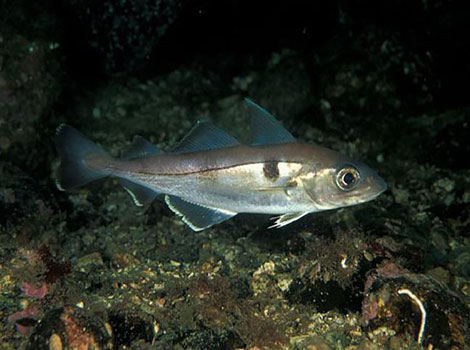
| Attributes | Quick facts |
|---|---|
| Size | 14–24 inches (35–61 cm) |
| Weight | 2–7 lb (0.9–3.2 kg) |
| Lifespan | 10–14 years |
| Habitat | Cold, deep waters of the North Atlantic Ocean |
| Diet | Crustaceans, mollusks, and small fish |
| Social Structure | Schools |
| Conservation | Vulnerable |
Fun Fact: Haddock is a culinary favorite, especially in Europe, where it features in smoked dishes and the classic fish and chips, prized for its mild, flaky flesh!
65. Hammerhead Shark
The Hammerhead Shark, a member of the Sphyrnidae family, includes nine species ranging from 3 to 20 feet in length and up to 1,300 pounds. Found in temperate and tropical oceans worldwide, they inhabit coastal and offshore waters, preferring depths up to 260 feet but capable of diving deeper. Their iconic hammer-shaped head, or cephalofoil, enhances sensory perception, vision, and agility. With a grayish to olive-green dorsal side and lighter underside, they blend seamlessly into their marine environment.
These powerful predators feed on fish, squid, crustaceans, and rays, using their cephalofoil to pin stingrays to the ocean floor. Some species are solitary, while others, like the scalloped hammerhead, form large schools. Hammerheads are viviparous, birthing litters of 6–50 pups, which are independent from birth.
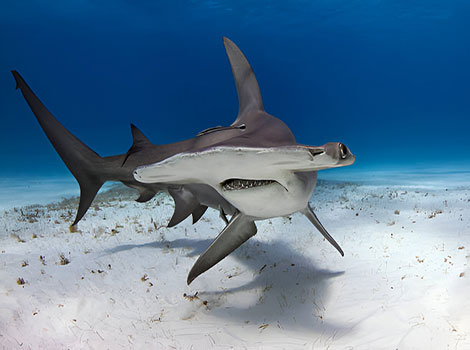
| Attributes | Quick facts |
|---|---|
| Size | 3–20 feet (1–6 meters, varies by species) |
| Weight | 6–1,300 lb (3–600 kg, varies by species) |
| Lifespan | 20–30 years |
| Habitat | Coastal and offshore waters in temperate and tropical oceans worldwide |
| Diet | Fish, squid, rays, and crustaceans |
| Social Structure | Solitary or schools, depending on species and age |
| Conservation | Endangered |
Fun Fact: The unique cephalofoil not only sharpens a hammerhead shark’s sensory detection but also allows them to make sharp turns, perfect for pursuing agile prey!
66. Humphead Wrasse
The Humphead Wrasse, a striking member of the Labridae family, is one of the largest reef fish, reaching lengths of 6–7 feet and weighing up to 420 pounds. Found in coral reefs across the Indo-Pacific, including the Red Sea and Great Barrier Reef, it inhabits depths of 3–100 feet. Known for its vibrant blue-green body with wavy patterns and a prominent forehead hump, this fish can change both color and sex during its lifetime.
A diurnal predator, it uses powerful jaws to feed on mollusks, crustaceans, and toxic prey like crown-of-thorns starfish, helping to maintain reef health. Typically solitary, it reproduces in open water, with eggs left to drift freely.
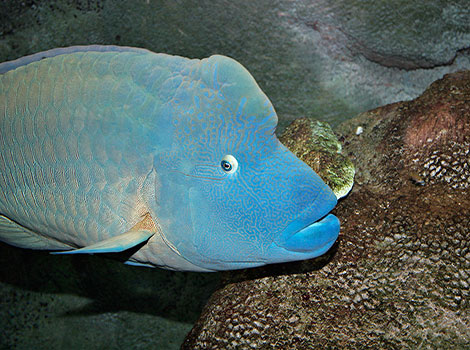
| Attributes | Quick facts |
|---|---|
| Size | 6–7 feet (1.8–2.1 meters) |
| Weight | Up to 420 lb (190 kg) |
| Lifespan | 30–50 years |
| Habitat | Coral reefs in the Indo-Pacific region |
| Diet | Mollusks, crustaceans, and fish, including toxic species like crown-of-thorns starfish |
| Social Structure | Solitary or small groups |
| Conservation | Endangered |
Fun Fact: As a protector of coral reefs, the Humphead Wrasse controls populations of destructive species like crown-of-thorns starfish, making it essential for reef ecosystems!
67. Hellbender
The Hellbender, a giant salamander in the Cryptobranchidae family, is one of North America’s largest amphibians, measuring 11.8–29 inches in length and weighing 3–5 pounds. It inhabits clean, fast-flowing streams and rivers in the eastern and central United States, relying on oxygen-rich water and rocky crevices for shelter and breeding. Its mottled brown, gray, or reddish skin provides excellent camouflage, while its flattened body and loose, wrinkled skin aid in navigating currents and absorbing oxygen.
A nocturnal predator, the Hellbender feeds on crayfish, small fish, and aquatic invertebrates, using a sit-and-wait strategy to ambush prey. During breeding season, males build and guard nests under rocks, aerating eggs until they hatch. However, no care is provided to larvae.
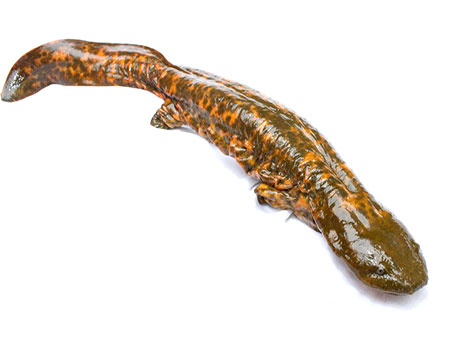
| Attributes | Quick facts |
|---|---|
| Size | 11.8–29 inches (30–74 cm) |
| Weight | 3–5 lb (1.4–2.3 kg) |
| Lifespan | 25–30 years (up to 50 years in captivity) |
| Habitat | Clean, fast-flowing streams and rivers in eastern and central United States |
| Diet | Crayfish, small fish, and aquatic invertebrates |
| Social Structure | Solitary |
| Conservation | Near Threatened |
Fun Fact: Nicknamed “snot otters” or “lasagna lizards,” Hellbenders play a crucial role in maintaining aquatic ecosystems but face threats like pollution and habitat loss.
Transitioning from aquatic life, we now explore amphibians that start with ‘H.’ These dual-life creatures display remarkable traits and a fascinating evolutionary history.
Amphibians that start with H
Amphibians like the hellbender salamander are intriguing for their ability to live both on land and in water, showcasing unique biological and behavioral adaptations.
| Horned Frog | Holy Cross Frog |
68. Horned Frog
Horned Frogs, also known as Pacman frogs, belong to the Ceratophryidae family and are native to South America’s tropical rainforests, grasslands, and wetlands, particularly in Argentina, Brazil, and Uruguay. These amphibians range from 2–8 inches in length and weigh up to 2 pounds. Their green, brown, or yellow bodies with dark patches provide excellent camouflage, while horn-like projections above their eyes enhance their disguise. Their large mouths, resembling the arcade character Pac-Man, allow them to consume surprisingly large prey.
Carnivorous and solitary, Horned Frogs ambush insects, small rodents, and even other amphibians. Nocturnal by nature, they spend much of their time burrowed in soil, emerging at night to hunt. During the rainy season, females lay eggs in water, leaving tadpoles to develop independently.
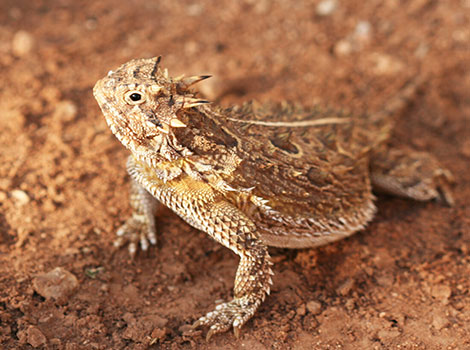
| Attributes | Quick facts |
|---|---|
| Size | 2–8 inches (5–20 cm, varies by species) |
| Weight | 0.4–2 lb (200–900 g) |
| Lifespan | 5–10 years |
| Habitat | Tropical rainforests, grasslands, and wetlands in South America |
| Diet | Insects, small rodents, and other amphibians |
| Social Structure | Solitary |
| Conservation | Least Concern |
Fun Fact: Nicknamed “mouths with legs,” Horned Frogs have enormous appetites, capable of swallowing prey nearly as large as themselves!
69. Holy Cross Frog
The Holy Cross Frog, a member of the Myobatrachidae family, is native to Australia’s arid and semi-arid regions. Measuring 2–3 inches in length and weighing up to 1.1 ounces, it inhabits sandy or clay-rich soils, often burrowing underground to escape heat and drought. Its olive-green or brown body features a distinctive cross-shaped pattern on its back, giving it its name. This plump frog produces a sticky, glue-like secretion to deter predators and stores water in its body to survive long dry spells.
Emerging during heavy rains, it forages on ants, termites, and other invertebrates, taking advantage of the abundant prey. Breeding occurs in temporary water bodies, with eggs developing rapidly into tadpoles without parental care before the pools evaporate.

| Attributes | Quick facts |
|---|---|
| Size | 2–3 inches (5–7.5 cm) |
| Weight | 0.7–1.1 oz (20–30 g) |
| Lifespan | 4–6 years |
| Habitat | Arid and semi-arid regions in Australia, often in temporary water bodies |
| Diet | Insects and small invertebrates |
| Social Structure | Solitary |
| Conservation | Least Concern |
Fun Fact: The Holy Cross Frog’s sticky skin secretion is being studied as a potential non-toxic medical glue, showcasing its unique biological properties!
From amphibians, we now turn to the world of insects beginning with ‘H,’ a group characterized by their vast diversity and essential ecological roles.
Insects that start with H
Insects such as honeybees and hornets are critical for pollination and ecosystem balance. These small but mighty creatures demonstrate the interconnectedness of life on Earth.
| Hornet | Horsefly | Hercules Beetle |
| Hissing Cockroach | Housefly | Horned Beetle |
| Hawk Moth Caterpillar | Hercules Moth | Hairy-footed Flower Bee |
| Hummingbird Hawk-Moth |
70. Hornet
Hornets, part of the Vespidae family, are large, robust insects measuring 1–2 inches in length and weighing up to 0.07 ounces. Found in forests, gardens, and urban areas, they build nests in trees, underground burrows, or sheltered structures. Hornets are typically marked with black and yellow or brown patterns, though species like the Asian Giant Hornet feature orange and black coloration. They possess powerful mandibles for hunting and building, along with a sharp stinger capable of delivering potent venom for defense and prey capture.
These eusocial insects live in colonies led by a queen, with sterile female workers managing foraging, nest defense, and feeding larvae. Adults feed on insects, tree sap, and nectar, while larvae are nourished with chewed-up insects. New queens and drones emerge in late summer or fall to form future colonies.
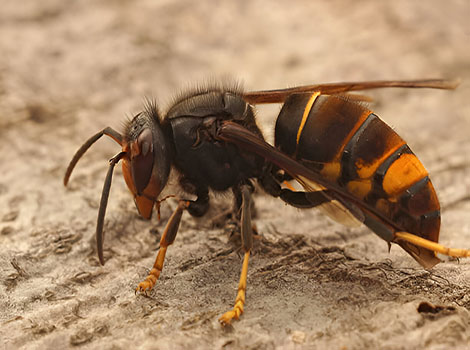
| Attributes | Quick facts |
|---|---|
| Size | 1–2 inches (2.5–5 cm) |
| Weight | 0.04–0.07 oz (1–2 g) |
| Lifespan | Workers: 2–3 weeks; Queens: up to 1 year |
| Habitat | Forests, gardens, and urban areas worldwide |
| Diet | Insects, tree sap, and fruit; larvae are fed chewed insects |
| Social Structure | Eusocial, living in colonies with a queen, workers, and drones |
| Conservation | Least Concern |
Fun Fact: Hornets are exceptional predators that help control insect populations, yet their venom is powerful enough to deter much larger animals!
71. Horsefly
The Horsefly, a member of the Tabanidae family, ranges from 0.4 to 1.2 inches in length and weighs up to 0.03 ounces. These robust insects thrive in wetlands, forests, and fields worldwide, especially near water essential for breeding. Their bodies are usually gray or black, with large, iridescent compound eyes that display vibrant, rainbow-like colors. Females possess sharp, scissor-like mouthparts for cutting skin to feed on blood, while males have softer mouthparts and feed solely on nectar and plant juices.
Active during warm, sunny days, females are persistent hunters, using visual and carbon dioxide cues to locate hosts. They lay eggs near water, where larvae hatch and feed on small insects or organic material, with no parental care involved.
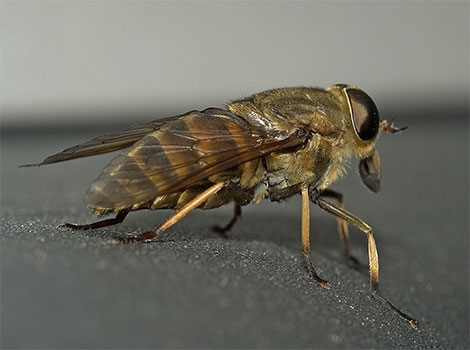
| Attributes | Quick facts |
|---|---|
| Size | 0.4–1.2 inches (1–3 cm) |
| Weight | 0.01–0.03 oz (0.3–1 g) |
| Lifespan | 30–60 days |
| Habitat | Wetlands, forests, and open fields worldwide |
| Diet | Males: nectar; Females: blood from mammals (for reproduction) |
| Social Structure | Solitary |
| Conservation | Least Concern |
Fun Fact: Horseflies are known for their massive, colorful eyes, among the largest in the insect world, making them easy to identify!
72. Hercules Beetle
The Hercules Beetle, part of the Dynastinae subfamily within Scarabaeidae, is a colossal insect found in the tropical rainforests of Central and South America. Measuring 1.5–7 inches (including horns) and weighing up to 3.5 ounces, it is one of the largest and heaviest beetles. Males are known for their striking forked horns, which can be as long as their bodies, used in battles for mates. Females, smaller and hornless, share the beetle’s shiny exoskeleton, which ranges from greenish-yellow to dark brown with black spots.
Larvae feed on decaying wood, aiding nutrient recycling, while adults prefer overripe or fermenting fruits. Solitary and nocturnal, males engage in dramatic horned battles to secure mates. Females lay eggs in decomposing material, providing food for larvae, which grow for 1–2 years before transforming into adults.
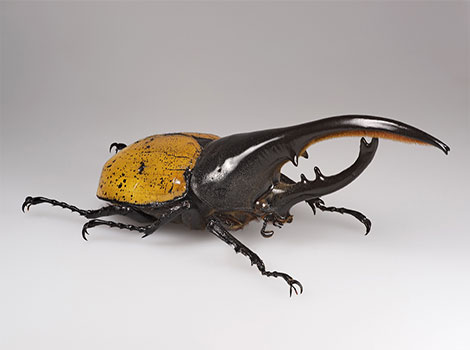
| Attributes | Quick facts |
|---|---|
| Size | 1.5–7 inches (4–17 cm, including horns) |
| Weight | 1.4–3.5 oz (40–100 g) |
| Lifespan | 1–2 years (larval stage), 3–6 months (adult stage) |
| Habitat | Tropical rainforests in Central and South America |
| Diet | Larvae: decaying wood; Adults: fruit and plant matter |
| Social Structure | Solitary |
| Conservation | Least Concern |
Fun Fact: Hercules Beetles can lift objects 850 times their body weight, showcasing their extraordinary strength!
73. Hissing Cockroach
The Hissing Cockroach, native to Madagascar, belongs to the Blaberidae family. Measuring 2–4 inches in length and weighing up to 1.2 ounces, these insects inhabit warm, humid forest floors, sheltering in decaying logs and organic material. They are dark brown to black with a shiny, smooth exoskeleton and are wingless but highly durable. A unique feature is their ability to produce a hissing sound by forcing air through spiracles on their abdomen, used for communication, mating, and defense.
These cockroaches feed on decaying plant matter and fruits, playing a vital role in nutrient recycling. They live in colonies with a hierarchy, where dominant males defend territories. Females carry eggs in a brood pouch until they hatch, and newly hatched nymphs remain briefly with their mother for protection.
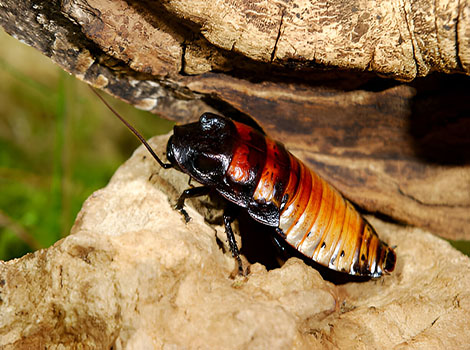
| Attributes | Quick facts |
|---|---|
| Size | 2–4 inches (5–10 cm) |
| Weight | 0.7–1.2 oz (20–35 g) |
| Lifespan | 2–5 years |
| Habitat | Forest floors and decaying logs in Madagascar |
| Diet | Decaying plant matter and fruits |
| Social Structure | Colonies with a hierarchical structure |
| Conservation | Least Concern |
Fun Fact: Known for their hissing abilities, these cockroaches are a favorite in educational displays and as exotic pets!
74. Housefly
The Housefly, a common insect in the Muscidae family, measures just 0.2–0.3 inches in length and weighs 2–3 milligrams. Found worldwide, it thrives in urban and rural areas, particularly near decaying organic matter, garbage, or animal waste. Its grayish-black body features four dark thoracic stripes, an iridescent abdomen, and large reddish compound eyes for excellent vision. Transparent wings with distinct veining support its swift and erratic flight.
Houseflies are solitary but may gather around food sources, feeding on decaying organic material or sugary substances using their sponging mouthparts. Females lay eggs in warm, moist organic matter, where larvae (maggots) hatch and feed. These insects play no role in caring for their offspring.
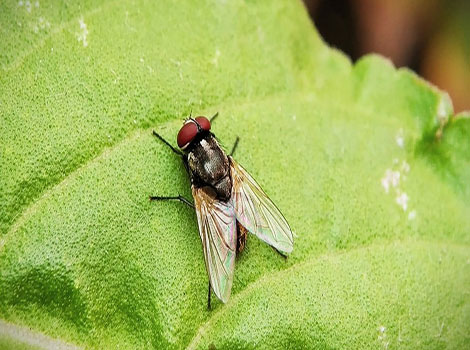
| Attributes | Quick facts |
|---|---|
| Size | 0.2–0.3 inches (5–8 mm) |
| Weight | 0.00007–0.0001 oz (2–3 mg) |
| Lifespan | 15–30 days |
| Habitat | Urban and rural areas worldwide, often near human activity |
| Diet | Decaying organic matter, garbage, and sugary substances |
| Social Structure | Solitary or groups near food sources |
| Conservation | Least Concern |
Fun Fact: Houseflies are speedy fliers, reaching up to 5 miles per hour and beating their wings an impressive 200 times per second!
75. Horned Beetle
The Horned Beetle, part of the Scarabaeidae family’s Dynastinae subfamily, includes impressive rhinoceros beetles. These beetles range from 1 to 6 inches in length and can weigh up to 3.5 ounces, with species like the Hercules Beetle reaching the largest sizes. Found in forests, grasslands, and agricultural areas worldwide, they thrive in warm climates but adapt to temperate regions. Their tough, armored bodies and prominent horns—most noticeable in males—aid in defense and competition. These beetles are typically black or dark brown, with some sporting glossy or metallic finishes.
Primarily nocturnal, Horned Beetles are solitary and active at night, searching for food or mates. Males use their horns in dramatic battles over territory or mates. Larvae, or grubs, feed on decomposing organic material, playing a key role in nutrient recycling.
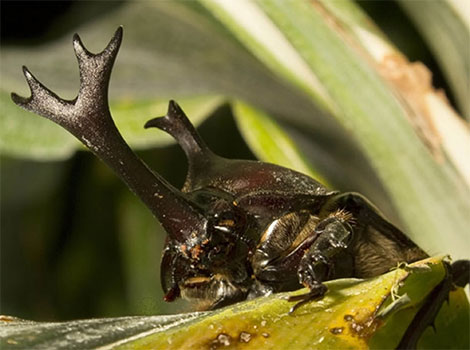
| Attributes | Quick facts |
|---|---|
| Size | 1–6 inches (2.5–15 cm, varies by species) |
| Weight | 0.1–3.5 oz (3–100 g, varies by species) |
| Lifespan | 3–6 months (adults) |
| Habitat | Forests, grasslands, and agricultural areas worldwide |
| Diet | Decaying wood, fruit, and plant matter |
| Social Structure | Solitary |
| Conservation | Least Concern |
Fun Fact: Horned Beetles are incredibly strong, capable of lifting objects 850 times their own body weight—a feat that makes them insect powerlifters!
76. Hawk Moth Caterpillar
The Hawk Moth Caterpillar, a member of the Sphingidae family, can grow to an impressive length of 3–6 inches and weigh up to 0.2 ounces. Found in forests, grasslands, and gardens worldwide, these caterpillars thrive in areas with abundant vegetation and host plants like tomato, tobacco, and willow. Their green or brown coloration provides excellent camouflage, while some species display eye spots to deter predators. A harmless, horn-like projection on their rear adds to their defense mechanisms.
Solitary in nature, they spend most of their time feeding voraciously on leaves, resting under foliage during the day to avoid threats. Adult moths lay eggs on host plants, and once hatched, caterpillars begin their life cycle with no parental care, feeding rapidly and growing in size.
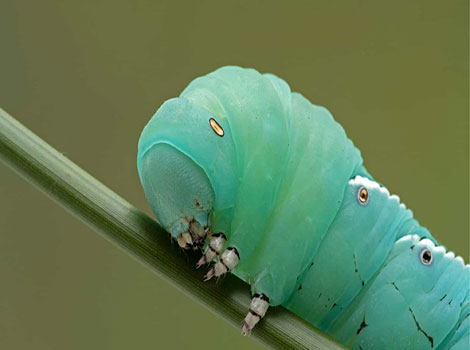
| Attributes | Quick facts |
|---|---|
| Size | 3–6 inches (7.5–15 cm) |
| Weight | 0.1–0.2 oz (3–6 g) |
| Lifespan | 2–5 weeks (caterpillar stage) |
| Habitat | Forests, grasslands, and gardens worldwide |
| Diet | Leaves of host plants (e.g., tomato, tobacco, and willow) |
| Social Structure | Solitary |
| Conservation | Least Concern |
Fun Fact: The Hawk Moth Caterpillar’s rear “horn” may look like a stinger, but it’s completely harmless, serving only to scare away predators!
Fun Fact: Hawk Moth Caterpillars are sometimes referred to as “hornworms” due to the presence of a distinctive horn-like structure at the posterior end of their bodies.
77. Hercules Moth
The Hercules Moth, one of the largest moths in the world, belongs to the Saturniidae family. Its wingspan ranges from 10–14 inches, and it weighs 0.4–0.6 ounces. This majestic insect resides in the tropical rainforests of Australia and New Guinea, favoring warm, humid environments with dense vegetation. Its light brown wings feature translucent eye spots for deterring predators, and males boast long, fern-like tails that enhance camouflage. While larvae feed on rainforest trees like Bleeding Heart and Silkwood, adults do not eat, relying entirely on reserves from their larval stage.
Primarily active at night, adult Hercules Moths have a short lifespan of 2–8 days, during which they focus on reproduction. Females lay eggs on host plants, and larvae fend for themselves, molting several times before creating durable cocoons.
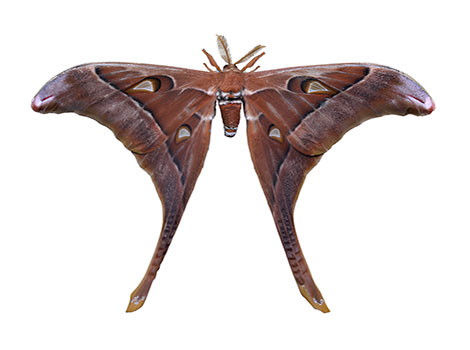
| Attributes | Quick facts |
|---|---|
| Size | 10–14 inches (25–35 cm, wingspan) |
| Weight | 0.4–0.6 oz (12–17 g) |
| Lifespan | 2–8 days (adult stage) |
| Habitat | Tropical rainforests in Australia and New Guinea |
| Diet | Larvae: leaves of rainforest trees; Adults: do not feed |
| Social Structure | Solitary |
| Conservation | Least Concern |
Fun Fact: The Hercules Moth’s tough cocoon is so sturdy that locals sometimes use it as a small storage container!
Fun Fact:
The Hercules Moth is named after the mythological hero Hercules due to its large size and strength, which is reflected in its impressive wingspan and robust body structure.
78. Hairy-footed Flower Bee
The Hairy-Footed Flower Bee, a member of the Apidae family, is a small, solitary bee measuring 0.4–0.6 inches in length. Found in gardens, meadows, and woodland edges across Europe and parts of Asia, it thrives in temperate climates with abundant flowers. Males are golden-brown with long hairs on their middle legs, while females are jet black with robust bodies. These bees are strong fliers with a hovering flight and a long tongue, allowing them to access deep flowers like lungworts and primroses for nectar and pollen.
Active in early spring, males patrol small territories, hovering in search of mates, while females focus on collecting pollen and nectar. Females construct nests in soft mortar or soil, filling them with provisions for their larvae, which develop and pupate without further care from the mother.
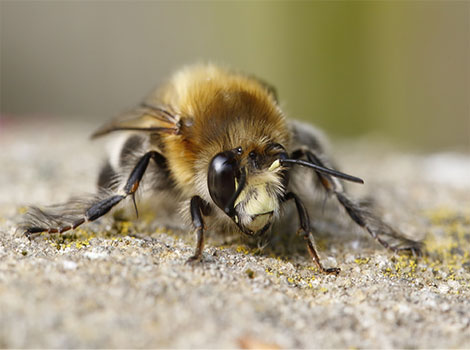
| Attributes | Quick facts |
|---|---|
| Size | 0.4–0.6 inches (1–1.5 cm) |
| Weight | 0.01–0.02 oz (0.3–0.6 g) |
| Lifespan | 6–8 weeks (active season) |
| Habitat | Gardens, meadows, and woodland edges in Europe and parts of Asia |
| Diet | Nectar and pollen from flowers |
| Social Structure | Solitary |
| Conservation | Least Concern |
Fun Fact: Despite their solitary lifestyle, Hairy-footed Flower Bees are often seen in large numbers foraging for nectar and pollen in gardens and natural habitat.
79. Hummingbird Hawk-Moth
The Hummingbird Hawk-Moth is a unique member of the Sphingidae family, known for its remarkable resemblance to hummingbirds in flight. This moth measures 1.6–1.8 inches in length with a wingspan of about 4–4.5 cm. Found across Europe, Asia, and North Africa, it thrives in gardens, meadows, and open spaces. Its migratory nature enables it to adapt to cooler climates by traveling to warmer regions during cold months. Its light brown or orange-brown body features vibrant orange hindwings that contrast with darker brown forewings. The rapid wing beats and its long, coiled proboscis make it an expert nectar feeder, hovering near flowers like a bird.
Unlike most moths, this species is active during the day and produces a distinct humming sound while flying. It frequently revisits flowers, showcasing behavior called trap-lining. Larvae, after hatching from eggs laid on host plants like bedstraws, develop in soil or sheltered spots.
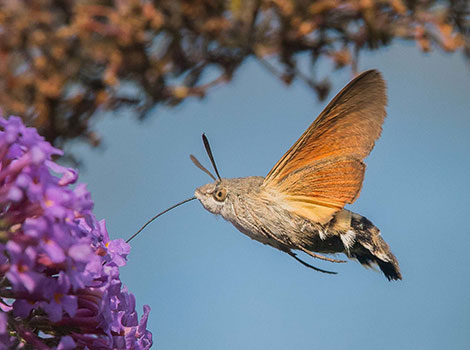
| Attributes | Quick facts |
|---|---|
| Size | 1.6–1.8 inches (4–4.5 cm, wingspan) |
| Weight | 0.07–0.09 oz (2–2.5 g) |
| Lifespan | 2–3 months |
| Habitat | Gardens, meadows, and open areas in Europe, Asia, and North Africa |
| Diet | Nectar from flowers |
| Social Structure | Solitary |
| Conservation | Least Concern |
Fun Fact: Hummingbird Hawk-Moths have the ability to navigate and feed on flowers in low light conditions, thanks to their keen eyesight and ability to detect ultraviolet wavelengths.
Lastly, we explore other animals starting with ‘H’ that don’t fall into the previous categories but are equally fascinating and vital to biodiversity.
Other animals that start with H
Animals like the humboldt squid and hermit crab highlight unique evolutionary paths. These creatures contribute to marine and terrestrial ecosystems in surprising and valuable ways.
| Huntsman Spider | Hobo Spider | Hammerhead Worm |
| Humboldt Squid | Hermit Crab |
80. Huntsman Spider
The Huntsman Spider, a member of the Sparassidae family, is known for its large size and remarkable speed. With a leg span of 3–6 inches and a weight of up to 0.4 ounces, these spiders inhabit tropical forests, caves, and human structures worldwide, thriving in warm, humid environments. Their flattened bodies and crab-like sideways legs allow them to squeeze into tight spaces. Typically brown, gray, or tan, they have banded legs and subtle patterns for camouflage.
Solitary and nocturnal, Huntsman Spiders hunt by ambushing prey like cockroaches, crickets, and moths, relying on speed and agility rather than webs. Females lay eggs in silk sacs and guard them fiercely until the spiderlings hatch and disperse.
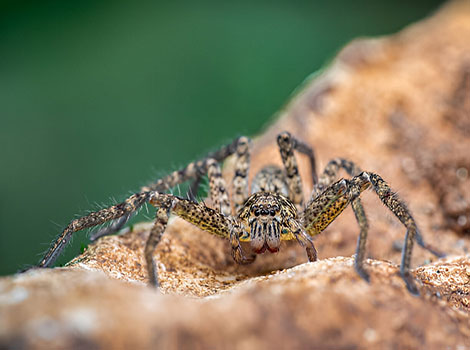
| Attributes | Quick facts |
|---|---|
| Size | 3–6 inches (7.5–15 cm, including leg span) |
| Weight | 0.1–0.4 oz (3–10 g) |
| Lifespan | 1–2 years |
| Habitat | Tropical forests, woodlands, caves, and human structures worldwide |
| Diet | Insects and small invertebrates |
| Social Structure | Solitary |
| Conservation | Least Concern |
Fun Fact: Huntsman Spiders have been introduced to new regions outside of their native range to help control pest populations, earning them the nickname “natural pest controllers.”
81. Hobo Spider
The Hobo Spider, a member of the Agelenidae family, is known for its funnel-shaped webs. Measuring 0.27–0.55 inches in body length and weighing up to 0.03 ounces, it inhabits grasslands, gardens, and human structures across Europe and North America. Preferring dry, warm environments, it often builds webs in cracks, crevices, or building corners. Brownish in color, it features a light stripe on its cephalothorax and a mottled pattern on its abdomen. Its long, hairy legs and horizontally aligned eyes are typical of funnel-web spiders.
Primarily nocturnal, the Hobo Spider ambushes insects and small invertebrates from the narrow end of its web. While not aggressive, it will retreat if disturbed. Females lay eggs in silk sacs and guard them until spiderlings hatch and disperse.
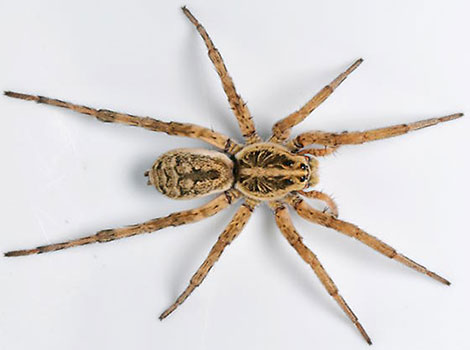
| Attributes | Quick facts |
|---|---|
| Size | 0.27–0.55 inches (7–14 mm, body length) |
| Weight | 0.01–0.03 oz (0.3–1 g) |
| Lifespan | 1–2 years |
| Habitat | Grasslands, gardens, and human structures in Europe and North America |
| Diet | Insects and other small invertebrates |
| Social Structure | Solitary |
| Conservation | Least Concern |
Fun Fact: Despite their common name suggesting otherwise, Hobo Spiders do not exhibit any particular inclination for hitchhiking or traveling on humans or their belongings.
82. Hammerhead Worm
The Hammerhead Worm, part of the Geoplanidae family, is a terrestrial flatworm known for its distinctive hammer-shaped head. Measuring 8–15 inches in length, it is one of the largest flatworms and thrives in moist soil, gardens, and forests in tropical and subtropical regions. However, invasive populations have spread to temperate areas. Its slimy body, marked by dark longitudinal stripes, is adapted for creeping over surfaces, and it possesses an extraordinary ability to regenerate lost body parts, including its head.
A nocturnal predator, the Hammerhead Worm preys on earthworms, secreting digestive enzymes to liquefy and ingest its victims. It reproduces both sexually, laying eggs, and asexually by fragmentation, with no parental care involved.
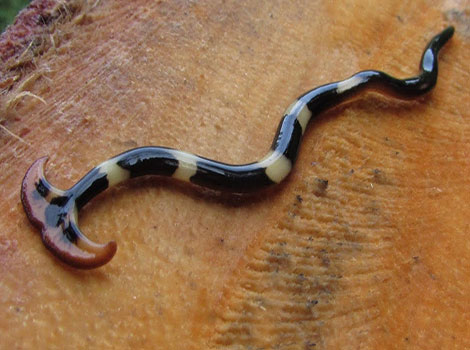
| Attributes | Quick facts |
|---|---|
| Size | 8–15 inches (20–38 cm) |
| Weight | Not readily available |
| Lifespan | Indeterminate; can regenerate indefinitely |
| Habitat | Moist soil, gardens, and forests, typically in tropical and subtropical regions |
| Diet | Earthworms and other small invertebrates |
| Social Structure | Solitary |
| Conservation | Least Concern |
Fun Fact: Hammerhead worms are hermaphroditic, meaning they possess both male and female reproductive organs.
83. Humboldt Squid
The Humboldt Squid, or “Red Devil,” is a formidable predator from the Ommastrephidae family. Growing 4–6 feet long and weighing up to 100 pounds, it inhabits deep waters of the eastern Pacific, particularly near Mexico, Peru, and Chile. Known for its reddish-brown coloration, this squid displays vivid hues when agitated. Its tentacles, lined with sharp-toothed suction cups, help capture fish, crustaceans, and even smaller squids, which it consumes using its strong beak.
Living in massive shoals, Humboldt Squid perform vertical migrations, rising to shallower waters at night to hunt and returning to depths during the day. Females lay thousands of eggs in gelatinous masses, leaving hatchlings to develop independently.
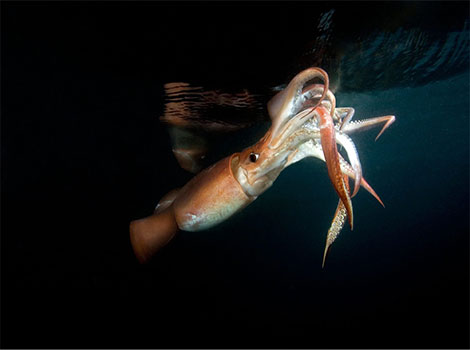
| Attributes | Quick facts |
|---|---|
| Size | 4–6 feet (1.2–1.8 meters) |
| Weight | 50–100 lb (23–45 kg) |
| Lifespan | 1–2 years |
| Habitat | Deep waters (200–700 meters) in the eastern Pacific Ocean |
| Diet | Fish, crustaceans, and other squid |
| Social Structure | Large shoals or groups |
| Conservation | Least Concern |
Fun Fact: Humboldt Squid are known for their aggressive behavior towards humans, earning them the nickname “red devils of the sea.”
84. Hermit Crab
Hermit crabs, members of the superfamily Paguroidea, come in a variety of sizes, from 0.5 to 16 inches in length and up to 11 pounds in weight, depending on the species. Found on coastal shorelines, tidal pools, and tropical beaches, they can be marine or terrestrial, with the latter requiring access to both land and water. Hermit crabs have soft abdomens protected by borrowed shells, long antennae, stalked eyes, and a pair of claws, one often larger for defense and foraging.
Omnivorous scavengers, they feed on algae, detritus, and small invertebrates, playing a crucial role in nutrient recycling. Communal by nature, they often gather in groups and participate in “shell swaps” to find better-fitting homes. Mating occurs in or near water, with females releasing eggs that hatch into planktonic larvae.
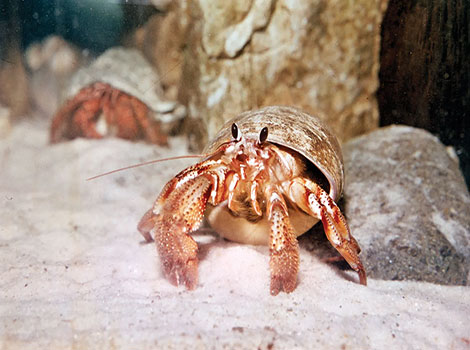
| Attributes | Quick facts |
|---|---|
| Size | 0.5–16 inches (1.3–40 cm, varies by species) |
| Weight | 0.01–11 lb (5 g–5 kg, varies by species) |
| Lifespan | 10–30 years (in the wild) |
| Habitat | Coastal shorelines, tidal pools, and tropical beaches worldwide |
| Diet | Algae, detritus, and small invertebrates |
| Social Structure | Communal; often found in groups |
| Conservation | Least Concern |
Fun Fact: Hermit crabs are known for their social behavior and often form groups, especially during molting periods when they are vulnerable.
FAQs
What sea animals that start with H?
Here are the top 5 sea animals that start with H:
- Humpback Whale (Megaptera novaeangliae): Humpback whales are majestic marine mammals known for their acrobatic breaches and haunting songs. They are often the highlight of whale-watching tours in various parts of the world.
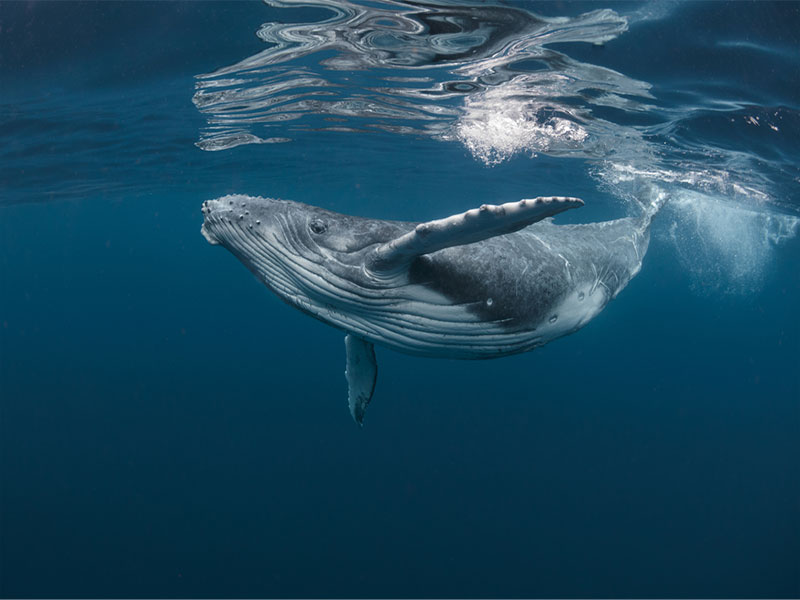
- Hammerhead Shark (Sphyrna spp.): Hammerhead sharks are instantly recognizable due to their unique hammer-shaped heads. They are apex predators found in tropical and temperate waters worldwide.
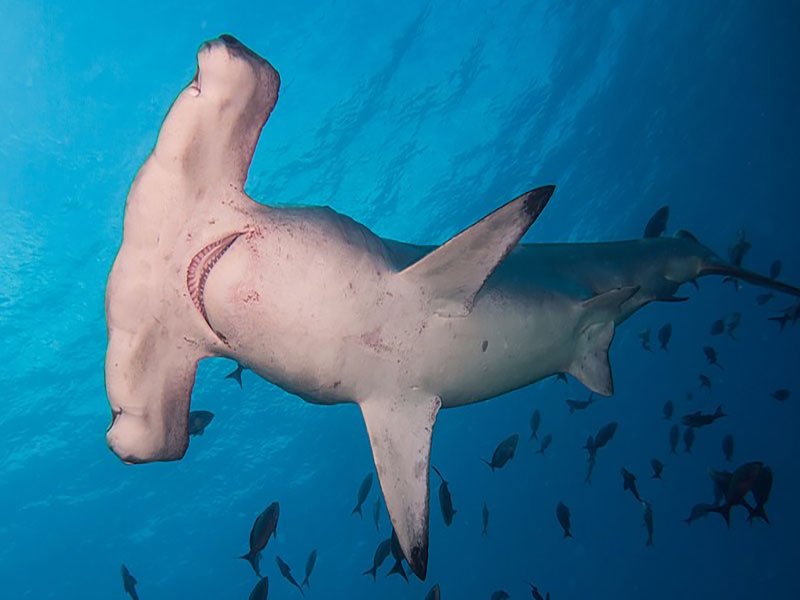
- Haddock (Melanogrammus aeglefinus): Haddock is a species of fish commonly found in the North Atlantic Ocean. They are important commercially and are known for their flaky white flesh, making them popular in seafood dishes.
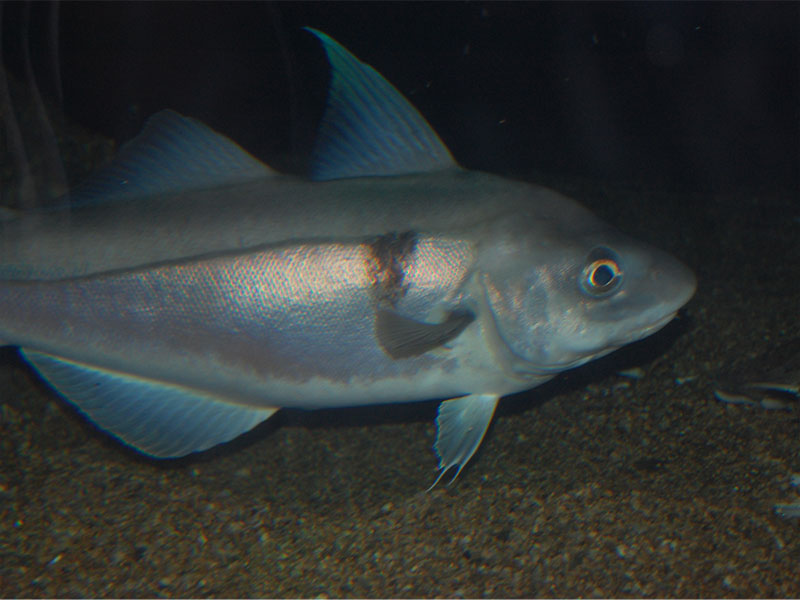
- Hagfish (Myxine spp.): Hagfish are primitive marine creatures that resemble eels. They are known for their slimy secretion, which they use for defense, and they play a crucial role in ocean ecosystems as scavengers.
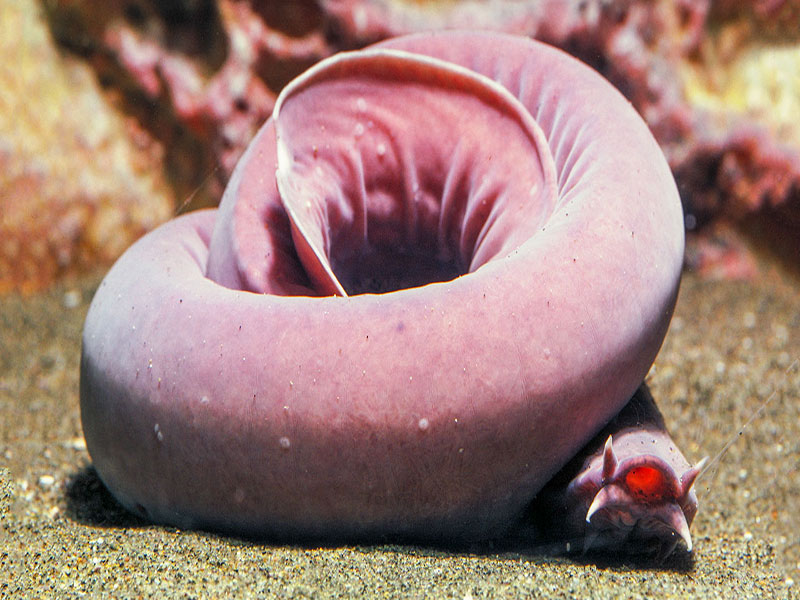
- Horseshoe Crab (Limulus polyphemus): Horseshoe crabs are ancient marine arthropods that have remained relatively unchanged for millions of years. They are often found in shallow coastal waters and are important for biomedical research due to their unique blood properties.
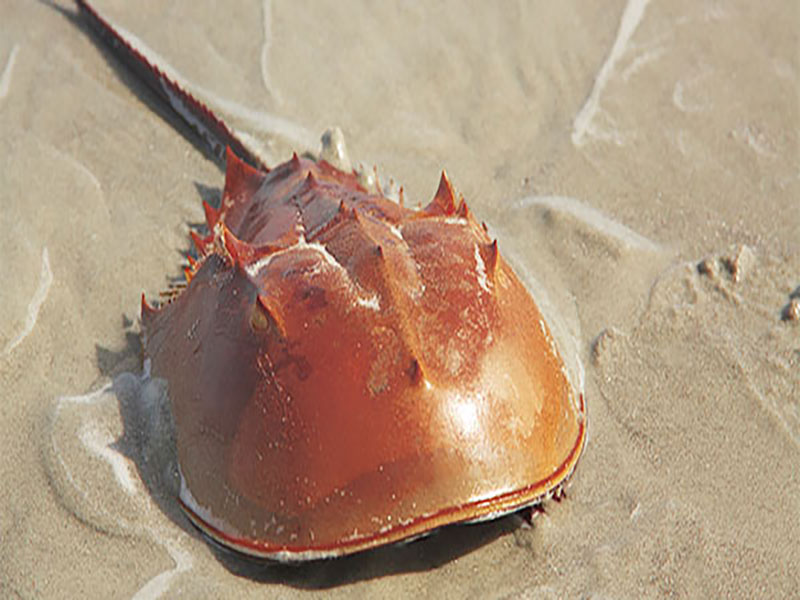
What insects that start with H?
Here are the top 5 insects that start with H:
- Honey Bee (Apis mellifera): Honey bees are social insects known for their role in pollination and honey production. They play a crucial role in ecosystems and agriculture.
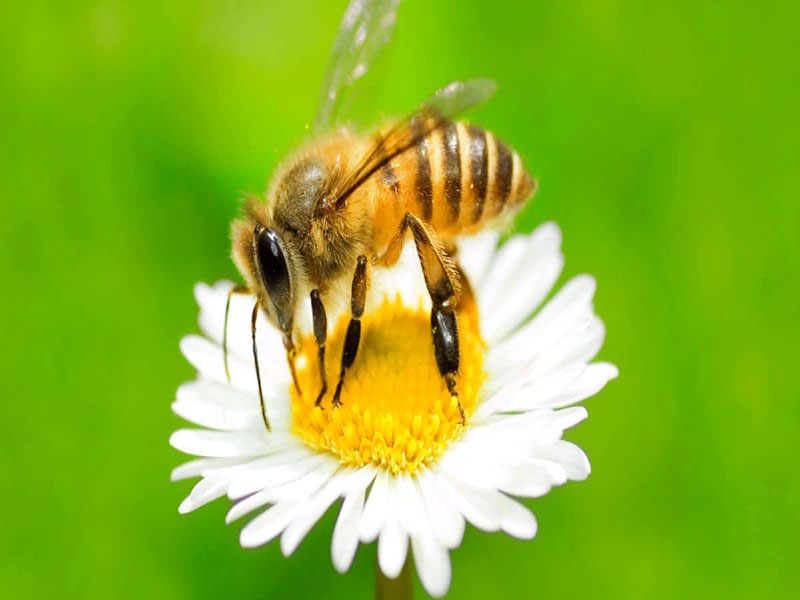
- Hercules Beetle (Dynastes hercules): Hercules beetles are large and impressive insects found in the tropical forests of Central and South America. Males have exaggerated horns, which they use in competitions for mates.
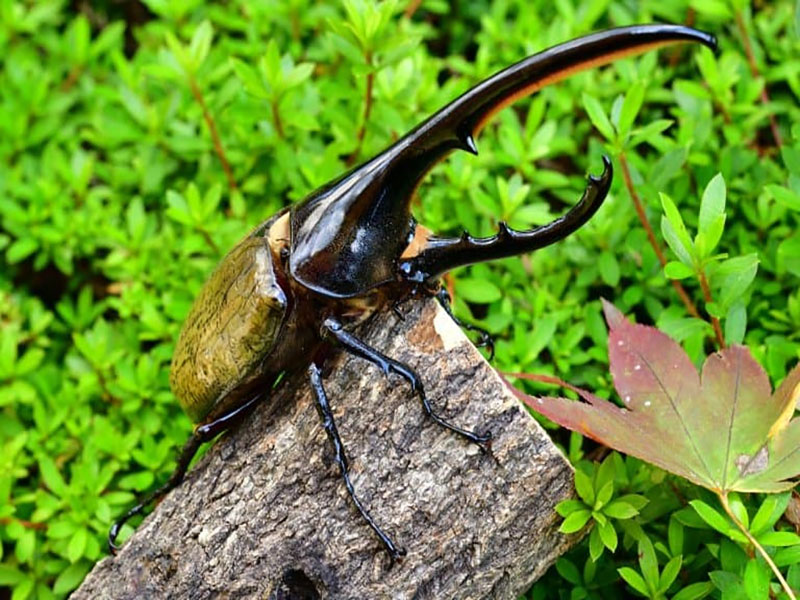
- Housefly (Musca domestica): Houseflies are common pests found worldwide. They are known for their rapid reproductive rates and association with unsanitary conditions.
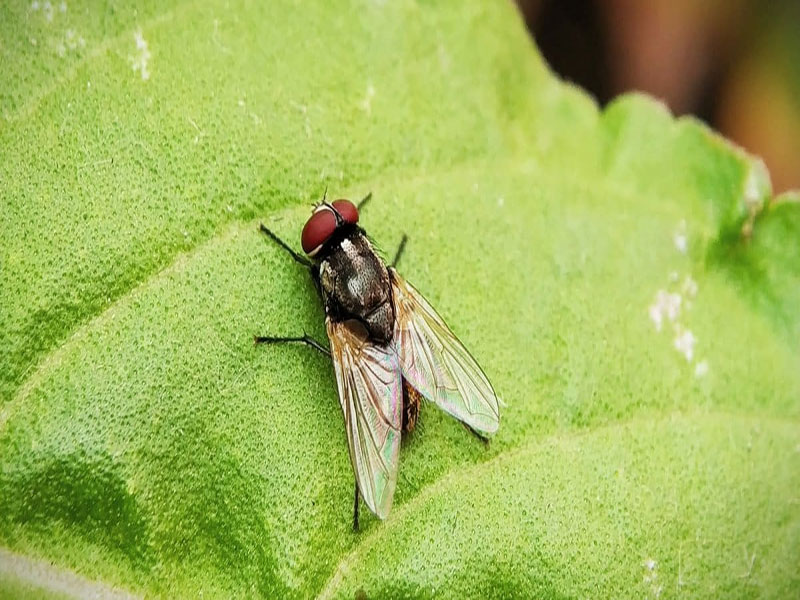
- Hornet (Vespa spp.): Hornets are large and aggressive wasps known for their powerful stings. They build intricate nests and are important predators of other insects.
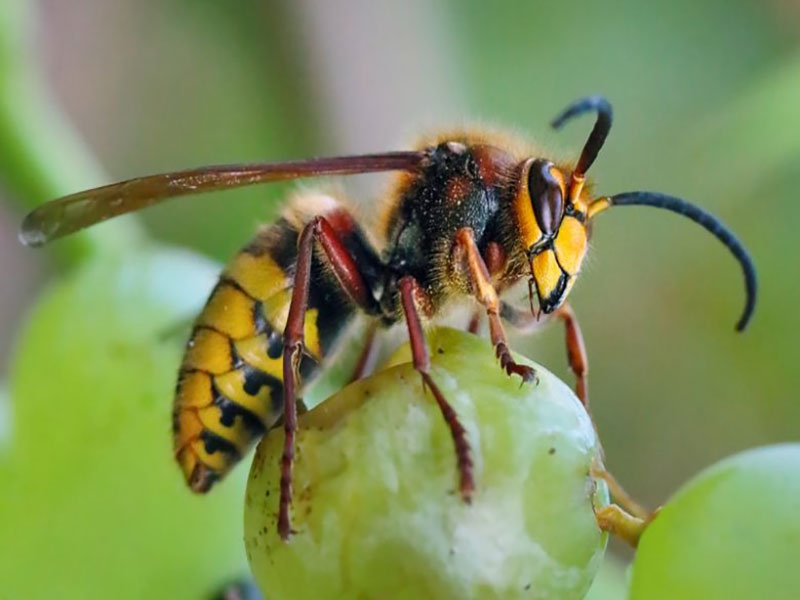
- Hissing Cockroach (Gromphadorhina spp.): Hissing cockroaches are large, wingless cockroaches native to Madagascar. They are popular as pets and are known for the hissing sound they produce when disturbed.
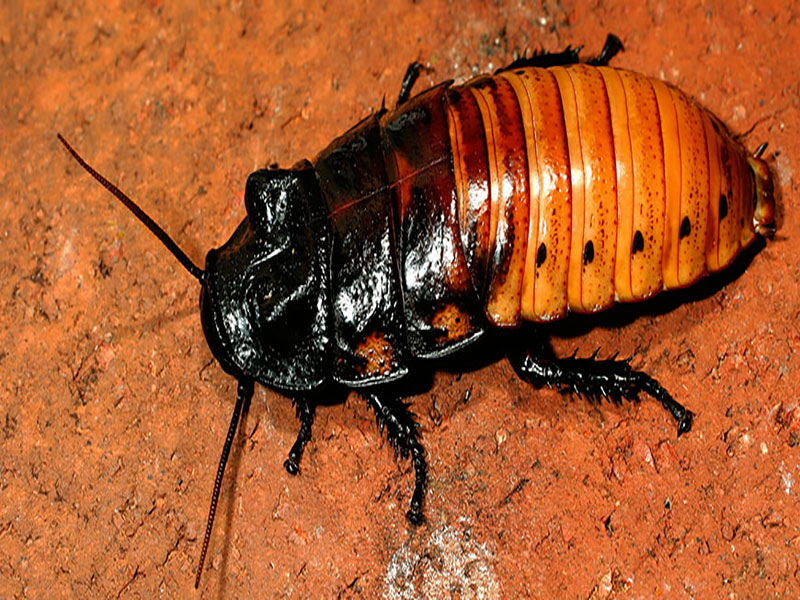
What reptiles that start with H?
Here are the top 5 reptiles that start with H:
- Hognose Snake (Heterodon spp.): Hognose snakes are non-venomous snakes found in North America. They are known for their upturned snouts and dramatic defensive displays, which include hissing and feigning death.
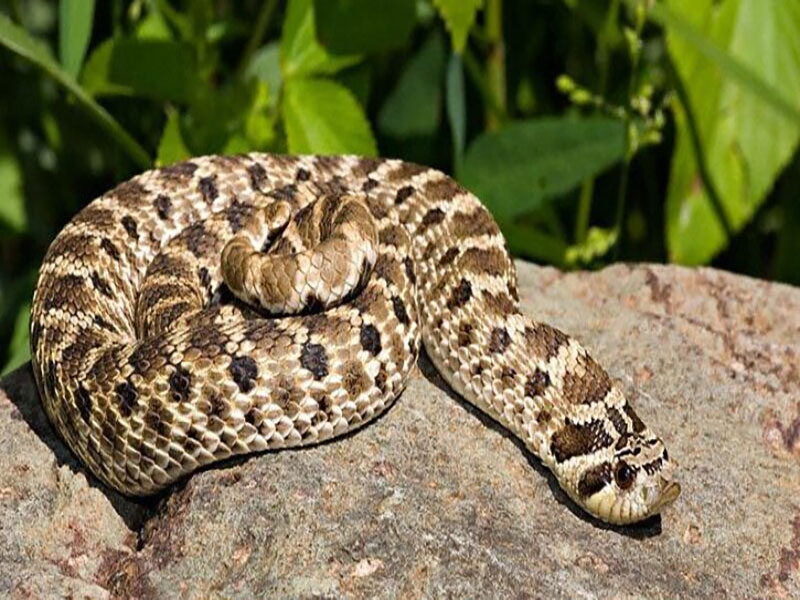
- Horned Lizard (Phrynosoma spp.): Horned lizards, also known as horned toads or horned frogs, are found in North and Central America. They have distinctive horns on their heads and are known for their ability to shoot blood from their eyes as a defense mechanism.
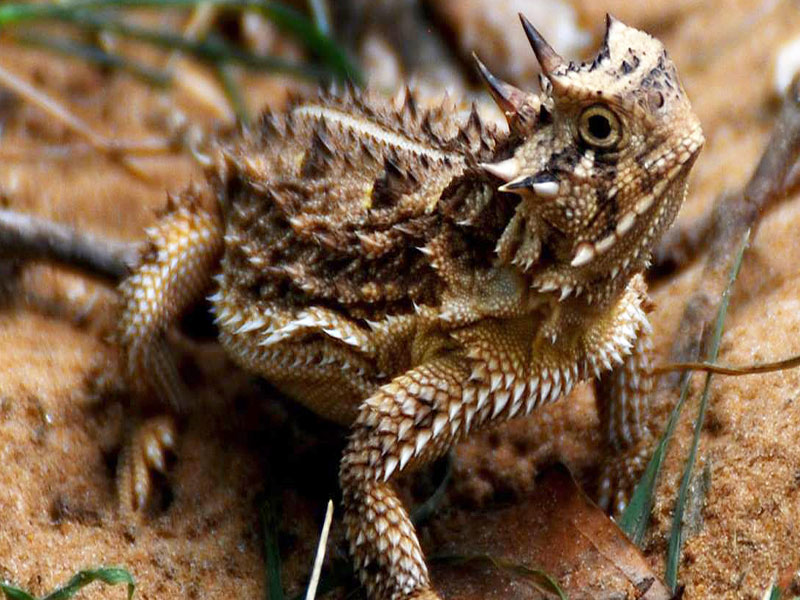
- Hatzegopteryx: Hatzegopteryx is an extinct genus of pterosaur that lived during the Late Cretaceous period. It was one of the largest flying reptiles known, with a wingspan estimated to be around 10-12 meters.
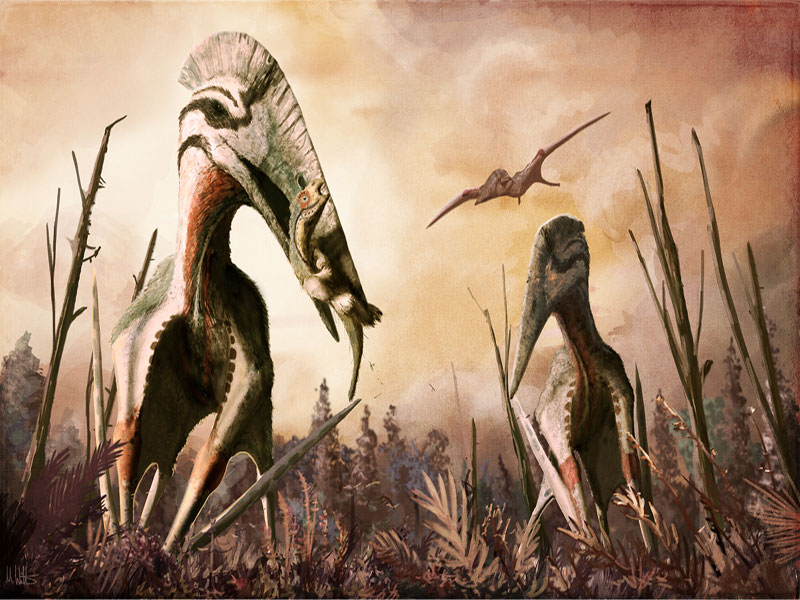
- Herrerasaurus: Herrerasaurus is an extinct genus of carnivorous dinosaur that lived during the Late Triassic period. It is one of the earliest known dinosaurs and is important for understanding the early evolution of dinosaurs.
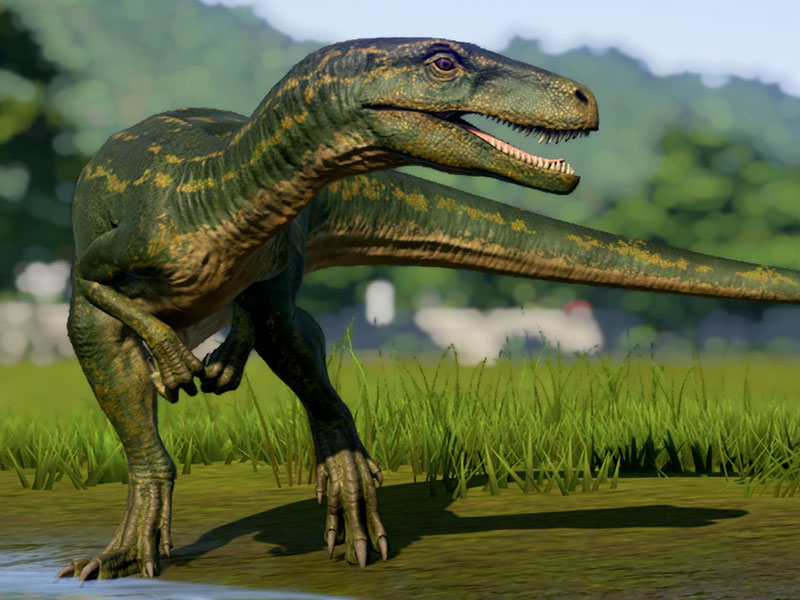
- Harlequin Coral Snake (Micrurus spp.): Harlequin coral snakes are venomous snakes found in Central and South America. They are known for their brightly colored bands and potent neurotoxic venom.
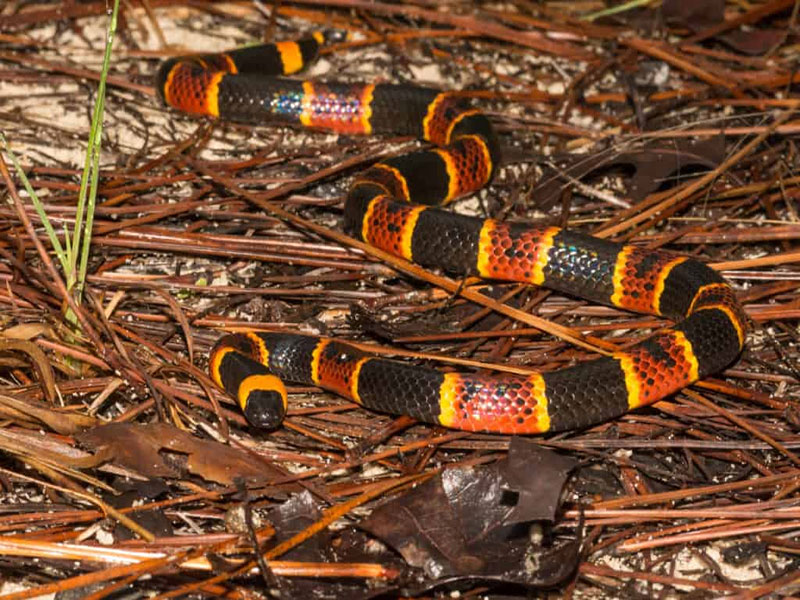
What cute animals that start with H?
Here are the top 5 cute animals that start with H:
- Hedgehog (Erinaceus europaeus): Hedgehogs are small, spiny mammals known for their adorable appearance and nocturnal habits. They are popular pets and are also found in the wild in various parts of the world.
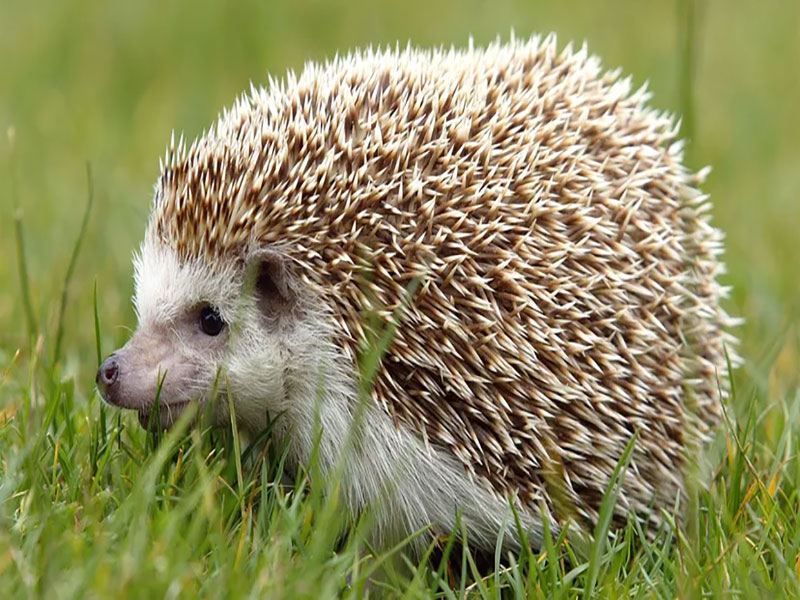
- Hamster (Cricetinae): Hamsters are small rodents often kept as pets due to their friendly demeanor and low maintenance care requirements. They are known for their habit of storing food in their cheek pouches.
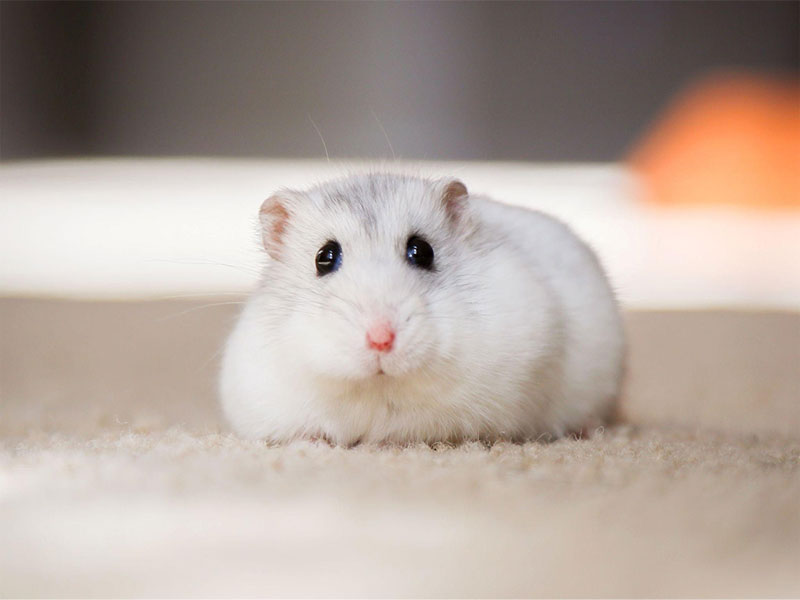
- Havanese (Canis lupus familiaris): Havanese dogs are small, affectionate breeds known for their silky fur and playful personalities. They are popular companion animals and are often used as therapy dogs.

- Highland Cattle (Bos taurus): Highland cattle are a Scottish breed of cattle known for their long, shaggy hair and impressive horns. They are raised for their meat and are also valued for their hardiness and adaptability to harsh climates.
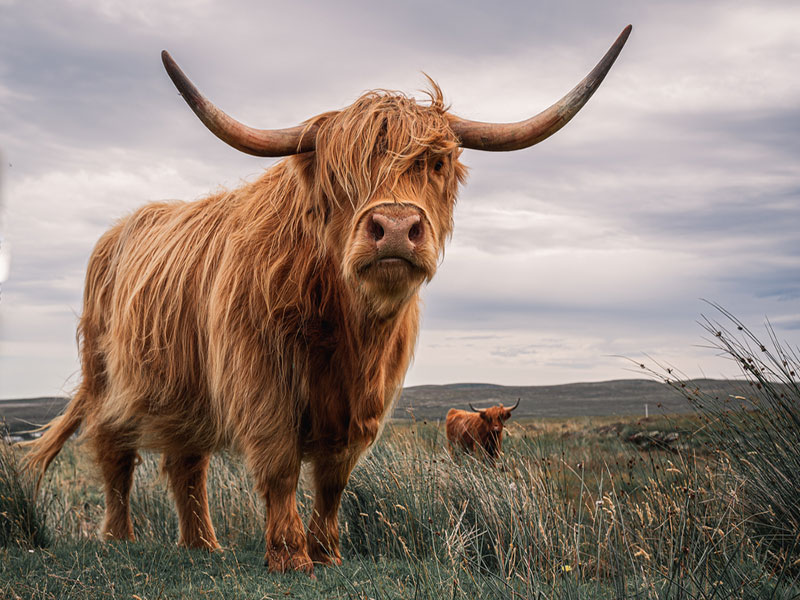
- Harp Seal (Pagophilus groenlandicus): Harp seals are adorable marine mammals known for their distinctive “harp-like” markings. They are found in the Arctic and are famous for their annual migration and breeding rituals on pack ice.
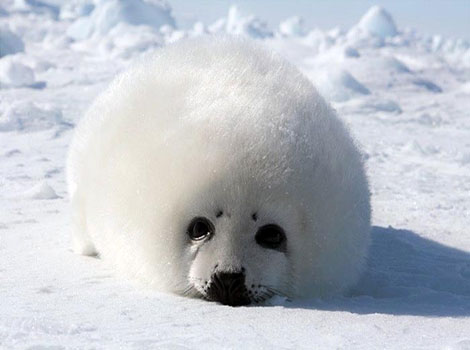
What rainforest animals that start with H?
Here are the top 5 rainforest animals that start with H:
- Howler Monkey (Alouatta spp.): Howler monkeys are large, vocal primates found in the rainforests of Central and South America. They are known for their loud howling calls, which can be heard over long distances.
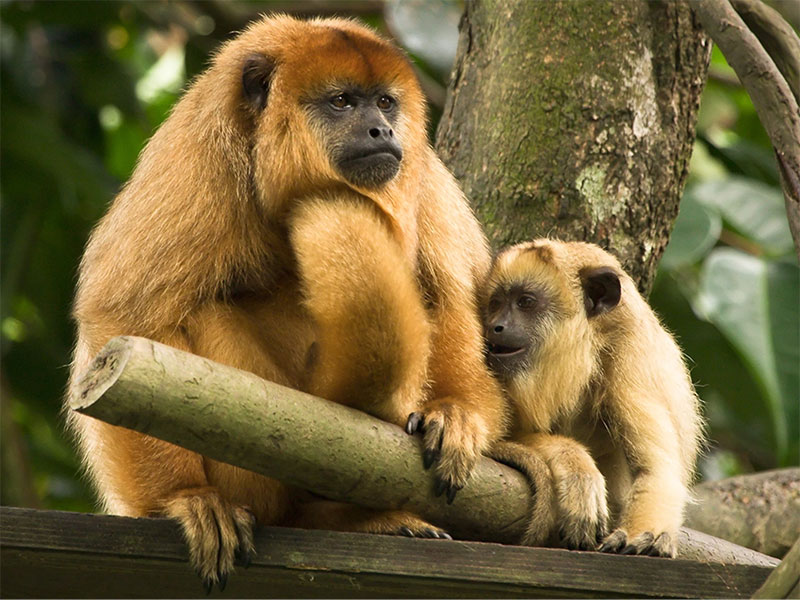
- Harpy Eagle (Harpia harpyja): Harpy eagles are majestic birds of prey found in the rainforests of Central and South America. They are one of the largest and most powerful eagles in the world and are known for their distinctive crest of feathers.
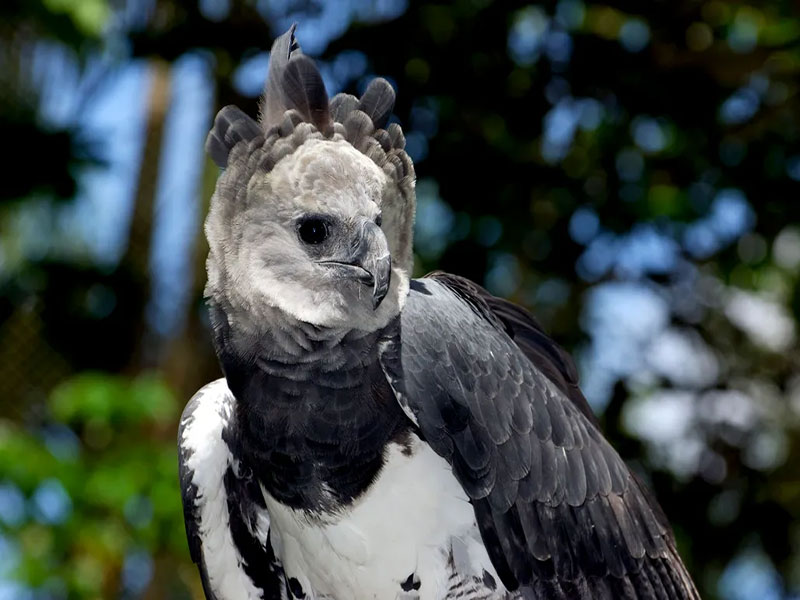
- Hoatzin (Opisthocomus hoazin): Hoatzins are unique birds found in the Amazon rainforest. They have a distinctive appearance with a spiky crest and blue facial skin, and they are known for their unusual digestive system and foul-smelling odor.
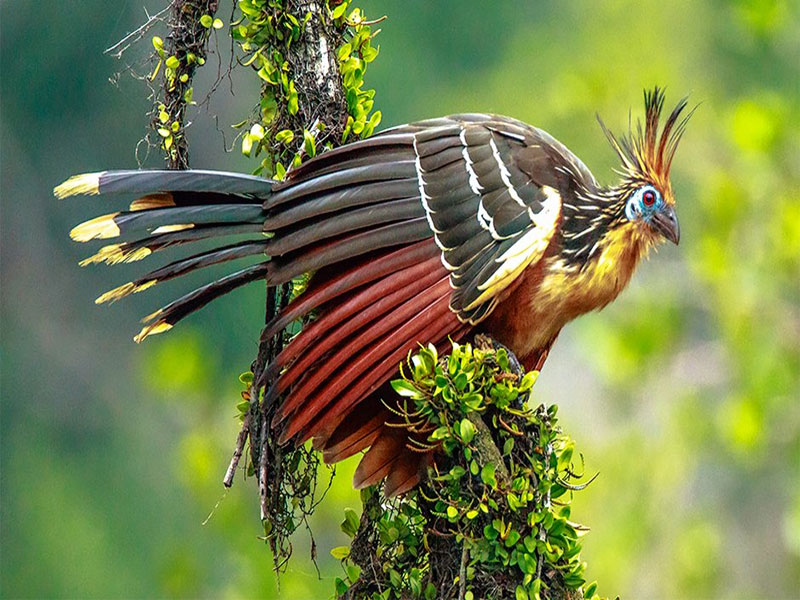
- Hylid Frog (Hylidae): Hylid frogs, also known as tree frogs or hylids, are a diverse family of frogs found in tropical rainforests around the world. They are known for their adhesive toe pads, which allow them to climb and cling to vegetation.
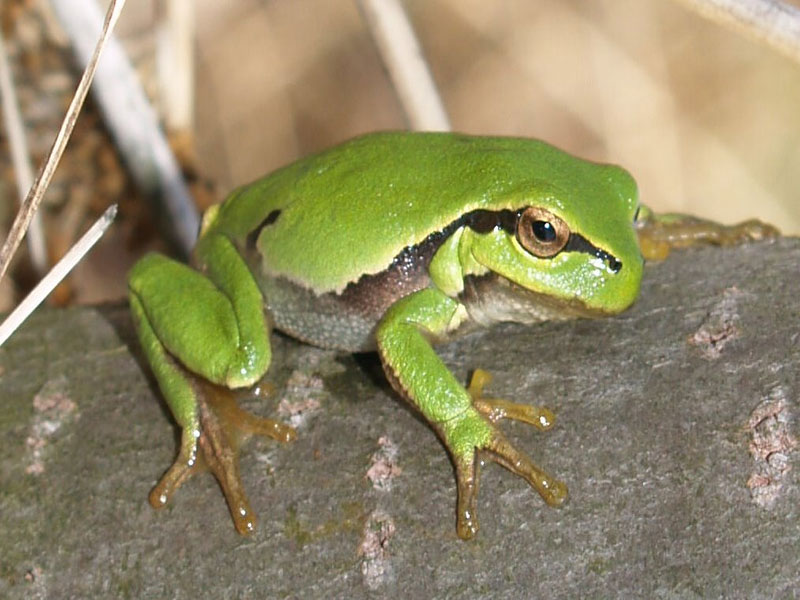
- Hairy Frog (Trichobatrachus robustus): Hairy frogs, also known as horror frogs or wolverine frogs, are found in Central Africa. They are unique among frogs because males have specialized claws that they can project from their toes as a defense mechanism.
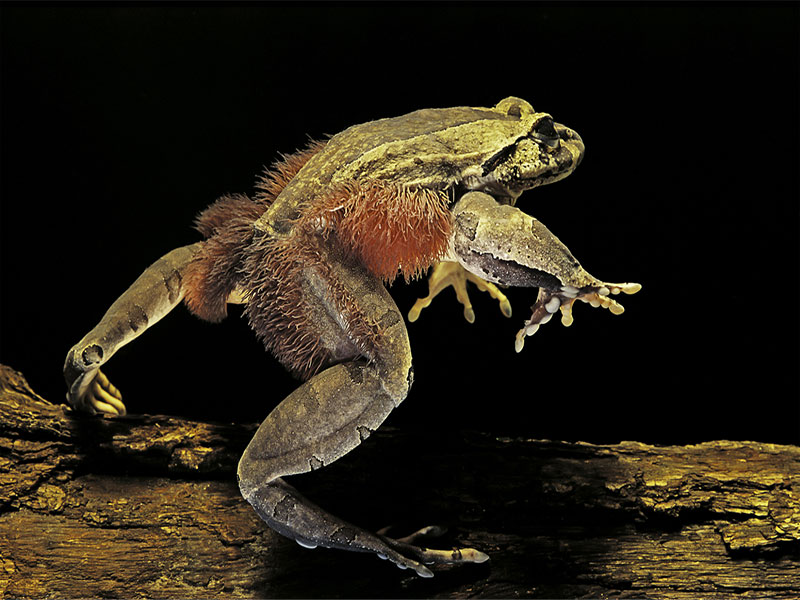
Exploring the captivating array of animals beginning with the letter H has truly opened a window into the wonders of our natural world. From the bustling habitats of hedgehogs to the elusive depths of the ocean where hammerhead sharks roam, these creatures inspire curiosity and appreciation for Earth’s incredible biodiversity. Keep discovering and nurturing your connection with wildlife—there’s always more to explore, learn, and marvel at. Your next adventure into the animal kingdom is just a heartbeat away!
If you’re searching for animal names starting with a different letter, explore our other comprehensive articles dedicated to animal names.
